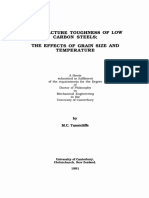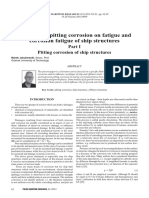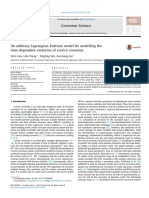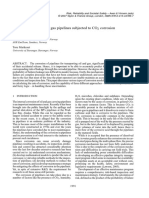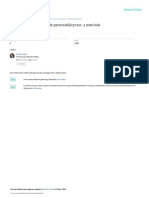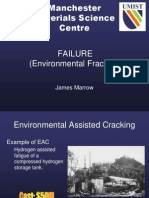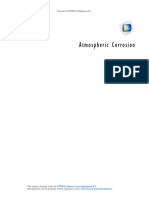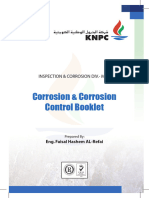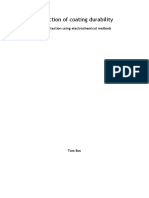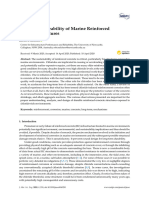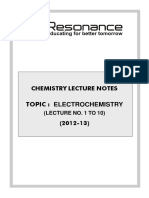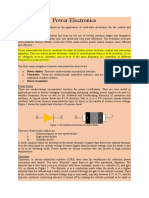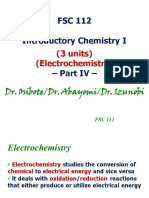Mas Iran Fer in The: Vrcu... "' ..
Mas Iran Fer in The: Vrcu... "' ..
Uploaded by
weider11Copyright:
Available Formats
Mas Iran Fer in The: Vrcu... "' ..
Mas Iran Fer in The: Vrcu... "' ..
Uploaded by
weider11Original Title
Copyright
Available Formats
Share this document
Did you find this document useful?
Is this content inappropriate?
Copyright:
Available Formats
Mas Iran Fer in The: Vrcu... "' ..
Mas Iran Fer in The: Vrcu... "' ..
Uploaded by
weider11Copyright:
Available Formats
r
f
..
-'-
A MATHEMATICAL MODEL FOR vrcu... "' ...,.L.Ir:>.
MAS IRAN FER IN THE DIF fO
LAYER
By
SHANNON DUGAN
Bachelor of Science
Oklahoma State University
Stillwater Oklahoma
1995
Submitted to the Faculty of the
Graduate College of the
Oklahoma State Univer ity
in partial fulfillment of
the requirements for
the Degree of
MASTER OF SCrE CE
May, 1999
OKLAHOMA STATE ITY
AMATHEMATICAL MODELFOR CALCULATING
MASS TRANSFER IN THE DIFFUSION
LAYER
-CA.L
L J ~ 8. Powd!
Dean of the Graduate College
ii
ACKNOWLEDGMENTS
First and foremost, I would like to thank God for giving me the opportunity to
enrich my life through this program and without whose grace I would not be where I am
today.
I wish to thank. those who have helped me, both directly and indirectly, to
successfully complete this Masters program. I would like to thank. Dr. Jan Wagner, my
adviser, for his valuable guidance, and technical assistance without which this work
might not have been possible. I would also like to thank Dr. Martin S. High and Dr. D.
Alan Tree for their guidance throughout the program.
This project was sponsored by the Downhole Corrosion Consortium whose
members are: Amoco, Conoco, GRI, Oryx and Phillips. I wish to thank all the sponsors
for their support.
I would also like to thank. my husband, Brian, whose support, both emotionally
and financially, is greatly treasured. I would also like to thank my parents and family for
helping me maintain sanity throughout this last year.
111
TABLE OF CONTENTS
Chapter
1. Introduction 1
1.1 The Difficulty of Predicting CO
2
Corrosion 1
1.2 The Importance ofPredicting CO
2
Corrosion 3
1.3 The Present CO
2
Corrosion Prediction Model.. .4
1.4 The Purpose ofThis Work 5
2. Literature Review 6
2.1 Electrochemical Reaction Mechanisms ofCO
z
Corrosion 6
2.2 Physical Model. '. 7
2.3 Mass Transfer Models 8
3. Diffusion Layer Modeling , 18
3.1 Existing Diffusion Layer Model in DREAM 18
3.2 Proposed Diffusion Layer Model Development 22
3.3 Determination ofBoundary Conditions 26
3.4 Comparison of Boundary Conditions for Reactive Species 30
4. Results 36
4.1 Comparison of Corrosion Rates 36
5. Conclusions and Recommendations 44
5.1 Conclusions 44
5.2 Recommendations 45
References 47
Appendix 50
IV
LIST OF TABLES
Table 1. Well Specifications for Case 1. 37
Table 2. Well Specifications for Case 2 : .39
Table 3. Well Specifications for Case 3 ; 40
Table 4. Comparison of Corrosion Rate Predictions ., .43
v
LIST OF FIGURES
Figure 1. Composite Structure of Con-osion Processes for Annular Two-Phase Flow 9
Figure 2. Fe++ Concentration vs. Normalized Diffusion Layer
Thickness for de Waard and Milliams Method 31
Figure 3. RCO)- Concentration vs. Normalized Diffusion Layer
Thickness for the de Waard and MiIliams Method .32
Figure 4. Fe++ Concentration vs. Normalized Diffusion Layer
Thickness for the Current Density Method 33
Figure 5. RCO)' Concentration vs. Normalized Diffusion Layer
Thickness for the Current Density Method 34
VI
NOMENCLATURE
b
a
anodic Tafel constant
b
k
cathodic Tafel constant
Cj concentration of species i, moles cm-
3
Dj diffusivity of species i, cm
2
S-1
E
eorr
corrosion potential, V
E
a
equilibrium potential of the anodic reaction, V
E
e
equilibrium potential of the cathodic reaction, V
F Faraday's constant, 96500 C mOrl
la anodic corrosion current density, rnA cm-
2
i
e
cathodic corrosion current density, rnA cm-
2
Ii current density of species i, rnA C ~ - 2
I
a
metal-dissolution current, rnA
L:orr corrosion current, rnA
J
j
flux of species i, mol cm-
2
5-
1
Nj flux density of species i, mol m-
2
S-1
P partial pressure, kPa
Q activation energy, J mOrl K
I
R universal gas constant
Rj reaction term, mol m-
2
S-1
vii
t temperature, C
T temperature, K
Uj
mobility of species i, mol Pa-
I
m-I S-I
Vi
fluid velocity, cm S-l
v
corrosion rate, mID yr-l
X dimensionless length of diffusion layer
y* thickness of the diffusion layer, cm
Zj charge of species i
Greek Symbols
1lc
<I>
Subscripts
o
avg
ads
anodic transfer coefficient
cathodic transfer coefficient
thickness of the Nemst diffusion layer, cm
anodic overpotential, V
cathodic overpotential
electrostatic potential, V
at the wall
at the turbulent-diffusion layer interface
average value
adsorbed
viii
bulk bulk property
ix
Chapter 1
Introduction
1.1 The Difficulty of Predicting CO
2
Corrosion
The extent of CO
2
corrosion depends on the action of many parameters:
temperature, pH, partial pressure of C02, water analysis, flow conditions, protective
films, etc. Many experimental studies have been performed on the effect of individual
parameters on CO
2
corrosion (de Waard and Milliams, 1975; Dugstad, 1994; de Waard
and Lotz, 1993). On the basis of these studies, the effects of individual parameters are
summarized as follows:
pH- Increased pH lowers the solubility of FeCO), giving a higher
probability for protective film formation. Higher pH also results in a lower
corrosion rate because of the decreased availability of hydrogen ions.
CO
2
- Higher CO
2
partial pressure increases the corrosion rate because the
pH is reduced.
Temperature - Higher temperature increases the corrosion rate because the
electrochemical reactions are accelerated. However, precipitation rates also
increase. Thus, protective films can form more easily at higher temperatures
and can lower the corrosion rate.
1
Protective films - FeC03 films are considered to be protective in many
cases. They reduce the corrosion rate by limiting the transport of chemical
species involved in the electrochemical reactions.
Flow - Higher flow rates usually increase the corrosion rates by increasing
the transport rates of reacting species to the metal surface by preventing or
destroying protective films.
Beyond the diversity of environmental conditions, the C02 corrosion of steels is basically
a very localized corrosion, which appears as pits and gutters of various sizes (Crolet,
1983).
For more than 50 years, laboratory experiments and theoretical models have been
challenged to accurately represent general corrosion of steels by CO
2
in oil industry
production waters (Trethewy, 1993). Except for extreme cases of erosion-corrosion, it
appears that a corrosion product layer always covers bare metal surfaces after long
exposures to aqueous CO
2
solutions. This observation is clear from field experience, but
it is also probably true for laboratory experiments. If bare surfaces exist after s h ~ r t
exposures, an increase in the duration of the exposure has always lead to an increased
probability of observing corrosion product layers (Dugstad, 1992). Typically, exposures
have never exceeded one month in laboratory tests (Dugstad, 1992). For example,
corrosion by H2S can take considerable time to develop and may go unnoticed in short-
term laboratory tests (Greco and Wright, 1962). Therefore, the effect of time on CO
2
and
H
2
S corrosion must be recognized as a phenomenon in its own right, especially when
extrapolating laboratory data to field data.
2
Field experience also reveals the protective behavior of certain corrosion product
layers. This is not merely the absence of corrosivity in the medium, but an absence of
corrosion under extremely aggressive conditions that typically cause rapid and deep
attack immediately adjacent to the protected areas. During well-servicing operations,
observations reveal that the real corrosivities are considerably lower than those measured
in the laboratory (Crolet, 1 9 9 3 ~ Trethewy, 1993). Therefore, empirical correction factors
reconcile experimentally found corrosion rates to the rates found in the field (de Waard
and Lotz, 1993). In particular, most corrosion "prediction" equations work reasonably
well when corrosion exists, however they fail when corrosion does not occur (Crolet,
1993).
1.2 The Importance of Predicting CO
2
Corrosion
The uniform corrosion rate of steel increases with increasing C02 concentration.
Early literature (Bacon et al., 1943, Hackerman et al., 1 9 4 9 ~ Bilhartz et al., 1952;
Greenwell, 1952) attributes this increase in corrosion rate to lowering of the solution pH
with CO
2
addition. On the basis of correlations between field observations, studies
carried out in the 1950's emphasized the effect of CO
2
partial pressure on the corrosivity
of a well through the acidizing of the water phase by carbonic acid (Bacon et al., 1943;
Bilhartz et aL, 1952). While this decrease in pH is a significant factor, it has been shown
that C02 has a more direct role in corrosion, and that corrosion rates are generally higher
in CO
2
solutions than in solutions of completely dissociated acids of the same
concentration (de Waard and Milliams, 1975).
3
At high CO
2
partial pressures, the uniform corrosion rates presented in much of
the literature are extremely high. To combat these high corrosion .rates the use of alloyed
production tubings has increased. However, the cost involved in placing alloyed tubings
in all wells is not economically feasible (Timmins, 1996). For C02 corrosion in the oil
and gas industry alone, the simple alternative between low alloy and stainless steels
represents differences in investment costs of billions of dollars (Trethewy, 1993).
Considering the significant cost associated with the replacement of corroded material, a
method of predicting the corrosivity of a well is significant.
1.3 The Present CO
2
Corrosion Prediction Model
Empirical models, based on experimental studies (de Waard and Milliams, 1975;
de Waard and Lotz, 1993; Nesic et al., 1995; Tewari and Campbell, 1979; Trethewy,
1993) are difficult to extrapolate and may have unrealistic limits that do not represent the
full gamut offield conditions (de Waard and Milliams, 1975; de Waard and Lotz, 1993).
These models have been the main tools used by industry to predict corrosion rates.
However, they require a limited number of parameters such as partial pressure of C02, pH
and temperature to calculate the corrosion rate. In addition, many of these models assume
that mass transfer effects are negligible.
A deterministic mass transfer model of uniform C02 corrosion rates in downhole
natural gas well environments, DREAM, has been developed for annular flow (Liu, 1993;
Sundaram et al., 1996). This model is composed of recent work in chemistry,
thermodynamics, mass transfer, and fluid flow. Recent research has been focused on the
improvement of the thermodynamic and pressure drop correlations of this model
4
(Sundaram et al., 1996). Although model predictions of corrosion rates compare fairly
well with caliper surveys obtained from welJs with widely varying corrosion
environments, the ability of the model to predict corrosion rates has been somewhat
insensitive to improvements in these two areas. Therefore, a new approach to diffusion
layer mass transfer modeling was taken.
1.4 The Purpose of This Work
The calculation of corrosion rates is dependent upon the temperature, pressure,
amount of species diffusing to the surface, and the kinetic parameters at the surface. The
primary purpose of this work is to:
Survey previous work done on improvements to DREAM (Liu, 1991;
Sundaram, 1996).
Evaluate the current mass transfer model in DREAM and determine the
deficiencies of the modeL
Compare empirical fonnulations (de Waard and Milliams, 1975; de Waard
and Lotz, 1993; Nesic et al., 1995; Tewari and Campbell, 1979; Trethewy,
1993) to those relying on fundamental principles and incorporate the best
available correlation into DREAM.
Ensure that the reactions of the active species at the wall are taken into
account in the diffusion layer model.
5
Chapter 2
Literature Review
2.1 Electrochemical Reaction Mechanisms of CO
2
Corrosion
The unifonn corrosion of iron exposed to C ~ dissolved in water proceeds by
coupled electrochemical reactions. When no solid reaction products are formed, the
overall anodic dissolution reaction can be written as:
Fe ~ Fe
2
+ + 2e- (1)
This reaction appears to proceed through intermediates involving hydroxyl ions (OR") in
such a way that the rate of anodic dissolution decreases with decreasing pR from pH 5 to
pH 1 (Weickowski and Gahli, 1983). For example, Davies and Burstein (1980) proposed
the following mechanism for the anodic dissolution of iron:
Fe + 2H
2
0 ~ Fe(OHh + 2W+ 2e-
Fe + RC03" ~ FeC03 +W + 2e-
Fe(ORh + RC0
3
- ~ FeC03 + R
2
0 + OR-
FeC0
3
+ RC0
3
- F e ( C 0 3 h 2- + W
The rate determining step is the hydrogen evolution reaction, Equation 3.
The usual cathodic reaction is hydrogen evolution as expressed as:
2W+2e- -7 H
2
6
(2)
(3)
(4)
(5)
(6)
The increase in the rate of this reaction with decreasing pH more than offsets the pH
dependence of the reaction in Equation 1 (Weickowslci and Gahli, 1983), and the net
effect is that corrosion rates decrease with increasing pH from pH 4 to pH 6.
Carbon dioxide primarily affects the cathodic reaction rate. Since hydrogen
evolution is rate limiting, de Waard and Milliarns (1975) proposed that hydrogen
evolution could occur directly from carbonic acid as follows:
(H
2
CO3)ads +e- ~ Hads +HC0 3
HC03- + W ~ H
2
CO 3
Whereas Schmitt and Rothmann (1984) proposed a non-electrochemical reaction
mechanism with the rate detennined by, Reaction 10:
(C0
2
)soln ~ (C0
2
)ads
(C02)ads + H20 ~ (H2C03)ads
(H2C03)ads + e- ~ Hods + (HC03-)OOs
(7)
. (8)
(9)
(10)
(11)
Hydrogen atom combination to H
2
can occur via conventional routes. The overall
reaction is the same as Equation 6 and proceeds in two steps. For example, the Volmer-
Heyvrovsky mechanism can be applied to most metals (Gray et a1., 1989):
where Hads is adsorbed hydrogen on the surface. Since the hydrogen adsorbs to the
surface before reacting, the adsorbed hydrogen can be said to "catalyze" the hydrogen
evolution reaction.
7
(12)
(13)
2.2 Physical Model
The downhole system in a gas well can be physically described by examining the
corrosion process as follows (Sundaram et al., 1996): Natural gas with or without
formation water leaves the reservoir and enters the tubing at high temperature and
pressure (see Figure 1). Water condensation may occur at some upper position in the well
due to temperature and pressure gradients. Under most circumstances, gas flow rates are
relatively high, and the flow regime is classified as annular, two phase flow. The
corrosive gases, CO
2
and H
2
S, solubilize and dissociate in the liquid film and are
transported through the turbulent film layer to the diffusion layer. In this layer, the mass
transfer is dominated by diffusion and ion migration. Reactive species and dissolved
gases (HC0
3
", HS", CO
2
, and H2S) diffuse and migrate through the diffusion layer to the
tubing wall. The reactive species and dissolved gases (RC0
3
', HS', C02, and H2S) react
with ferrous ions at the wall to form a corrosion product layer either through a direct
formation reaction or through precipitation. This corrosion product layer remains
attached to the wall forming a protective layer. Disruption of this protective layer can be
caused by erosion and/or dissolution and is strongly influenced by the structure of fluid
flow (Trethewy, 1993).
2.3 Mass Transfer Models
Processes in which mass transfer is enhanced by chemical reaction are frequently
encountered in the process industry (Littel et al., 1991). The chemical reactions that can
occur in such processes range from a single irreversible reaction to multiple parallel and
consecutive reactions. Well-known examples are the amine gas-treating processes where
8
the acid gas components C ~ and H2S are consumed by a chemical reaction in the
alkanolamine solution during the absoxption step and subsequently released by the reverse
reaction (Versteeg et aI., 1989).
9
Sol
Sol
~
~
as
~
'"'
...:l
t;
~
~ ..::l
~
'""
CJ
'"'
as CJ
;l
C 5
...:l
.g
s..
~
U
~
r=
l
;>
~
c
~
'""
.u;
III
t.:).
r=
!5
r=
as
~
-
c
.c
::I
Q
or;;
~ ,.Q
I
'"'
e
c
~
""
0
~
-.
u
-
Figure 1. Composite Structure of Corrosion Processes for Annular Two-Phase Flow
(Sundaram et aI., 1996)
10
Several numerical models th.at describe gas absoJ'Ption accompanied by chemical
reaction have been described in the literature (Kvarek.vaI, 1997; Comelisse et al., 1980;
Versteeg et al., 1989; Versteeg et al., 1990; Bosch et al., 1989; Littel et al., 1991) .
KvarekvaI (1997) developed a model that simulates the conditions in the stagnant layer
close to a dissolving iron surface, where heterogeneous reaction of W ions and H2C03
occurs. One-dimensional diffusion was calculated using a finite element method.
Homogeneous chemical reaction rates are determined from the rate constants and
differential rate expressions. The assumptions of this model include the following:
The cathodic rate of reaction is controlled by the transport of W ions and
carbonic acid.
. The flux of molecules is exclusively caused by diffusion.
The diffusion is one-dimensional, and occurs only in the diffusion layer.
Diffusion of each species involved (H+, H
2
C0
3
CO
2
, HC03', col', OH' and
Fe
2
1 is independent of the others.
However, electroneutrality criteria are not strictly applied to each point in the diffusion
layer; the presumed presence of a supporting electrolyte is assumed to depress the electric
field set up by the diffusing ions. The mathematical method applied to this model was the
sequential explicit space point method. Concentration changes caused by one-
dimensional diffusion were calculated for all species by the following procedure:
During the time the concentration of an arbitrary ion or molecule at the
point i in the diffusion layer changes from Cj to C'i.
11
(14)
The magnitude of the change is ACj, and depends on the concentrations of the
particular species at the adjacent points i-I and i +1.
(15)
where 0 is the diffusion coefficient of the specific ion or molecule and h is the
distance of each step in the numerical method.
The model results are strongly dependent upon the time step for unsteady state
predictions. If this time step is too large, the fast are "degraded" to slower
reactions, thereby, decreasing their weighted effect on the results. A large time step could
also exaggerate the diffusion in the diffusion layer. This model overpredicted corrosion
rates from25% up to 250%. Consequently, the results of this model are purely
theoretical "worst case" predictions for the given conditions.
Comelisse et aI. (1980) created a mass transfer model for a system involving the
simultaneous transfer of two components from or to a medium where complex, reversible
reactions take place. The specific application, represented in the following equations,
was the simultaneous transfer of COz and HzS into and out of an amine solution.
COz + 2R
2
NH R
2
NHt + RzNCOO'
The kinetics of this system were obtained from the published literature:
where R is the rate of transfer of C02 into and out of an amine solution.
12
(16)
(17)
(18)
To reduce the number of parameters and variables, only overall reactions were
considered. The stagnant film model described the mass transfer in the gas phase, as no
reaction occurs in this region. Higbie's penetration theory (Bird et al., 1960) was applied
to the liquid phase mass transfer. The model begins with total species balances and ends
with a total acid balance that states that the accumulation of acid is equal to the net inflow
by diffusion. This model, however is restricted to only a few stoichiometric schemes.
One drawback to this approach is that the diffusivities of each species were averaged and
a mean diffusivity was used. The mathematical treatment of this model is as follows:
The equations are fIrst transformed into dimensionless form and then discretized. A
three-point backward-difference numerical scheme is then used to numerically solve for
the mass transfer rates (Baker and Oliphant, 1960; Comelisse et al., 1980). This
numerical method is not only quite involved, but also introduces a large truncation error
into the result (Versteeg et al., 1989). Therefore, the accuracy of this model is subject to
the minimization of this truncation error.
Versteeg et al. (1989, 1990) presented a numerical model that describes the
absorption of a gas accompanied by multiple parallel, reversible chemical reactions.
Their objective to describe the absorption of CO
2
and H
2
S in alkanolamine solutions laid
the framework for the reaction schemes modeled. The reaction stoichiometry and the
reaction rate expressions were of a generalized form:
A(g) + +'YdD(l)
R
a
=k m,n,p.q [A]m[Bt[C]p[D]q - k r.s,t,v [AnBt[C]t[Dt
(19)
(20)
Versteeg et al. (1989) used Higbie's penetration model to describe the system in the
liquid phase. Material balances for each species yielded four nonlinear partial differential
13
equations (POEs). The concentration profiles are time dependent and were developed as
a system of coupled nonlinear POEs. These POEs were subject to specified initial and
two-point boundary conditions.
The model of Versteeg et aI. (1989) satisfactorily explained the experimentally
obtained absorption rates of CO
2
and H
2
S in aqueous solutions of aIkanolamines. Bosch
et al. (1989) successfully applied the same model to interpret literature data for the
absorption of CO
2
in sterically hindered amine solutions. However, the approximations
made are of restricted use and can be applied to only a limited number of reactions.
Furthermore, erroneous results occur when the linearization technique used is applied to
reversible reactions.
Some mathematical models that describe simultaneous absorption of CO
2
and H2S
in an alkanolarnine solution are presented in the literature ( Haimour and Sandall, 1983;
Bosch et al., 1989). The models of Haimour and Sandall (1983) describe the absorption
of H
2
S and C02 in secondary and tertiary amine solutions, in which interacting liquid
phase reactions were taken into account. Haimour and Sandall (1983) assumed
irreversibility and specific reaction rate expressions for the reactions involved, which
suggests that these models are of limited use.
The penetration theory model presented by Bosch et aI. (1989) describes
simultaneous absorption of H
2
S and CO
2
in mixtures of atkanolamines. Bosch et
al.(1989) assumed reversibility, generalized reaction rate expressions, and generalized
stoichiometry. Therefore, the general applicability of their model is limited only by the
type of reactions modeled. However, some parallel and consecutive reactions were not
taken into account in this model. Ionic species were involved in all reactions which take
14
place in aqueous amine solutions, but this model did not account for the concentration
changes of these species.
Most models presented in the literature have not accounted for the coupling of the
diffusion of ionic species. Diffusion of ionic species has been modeled similar to that of
neutral species and electroneutrality maintained by applying a mean ion diffusivity.
However, Littel et al. (1991) developed a numerical model based on Higbie's penetration
theory to study the effect of the coupled diffusion of ions and parallel and consecutive
reactions on the simultaneous absorption of H
2
5 and CO
2
in aqueous solutions of
alkanolamines. The following reactions describe the system:
CO
2
+ R
3
N + H
2
0 ~ R 3 N W + HC03' (21)
CO
2
+2R2NH R
2
NJIIT + R
2
NCOO' (22)
CO
2
+ OH- ~ HC0
3
- (23)
H
2
5 + OH- = HS- + H
2
O (24)
HC0
3
' + OK =CO? +H2O (25)
R
3
NH+ + OH- =R2NH + H
2
O (26)
H
3
0+ + OH- = 2H
2
O (27)
HS + OR- = 5
2
- + H
2
O (28)
Littel et al. (1991) believed that the mass transfer rates of ionic species is greatly affected
. by the reverse reaction rates. Littel et aI. (1991) also held that ionic species do not diffuse
independently of each other, rather that the diffusion of ions is coupled to maintain
electroneutrality throughout the system. The Nernst-Plank equation describes this
coupling of the diffusion of ionic species.
]5
Littel et al. (1991) compared their model with two of their les rigorous models.
One of these less rigorous models described the diffusion of ionic species by assuming
equal diffusivities for all ionic species, with the same reaction scheme used in the
complex model. The second less rigorous model also assumed equal diffusivities, but
took into account only the following direct reactions of CO
2
and H
2
S.
CO
2
+R ~ + H
2
0 ~ R 3 N " l r +HC0
3
-
CO
2
+ 2R
2
NH R
2
NM + R
2
NCOO-
H
2
S + R
3
N = R
3
NIr + HS-
H2S + R
2
NH = R2NH2+ + HS-
(30)
(29)
(31)
(32)
Comparing these models they concluded that incorporating all relevant reactions in the
mass transfer model instead of only the direct reactions between CO
2
and H
2
S results
only minor changes absorption rate predictions. However, incorporating the coupling of
the diffusion of ions in the mass transfer model can result in a significant effect on the
mass transfer rate of up to 20% (Littel et al., 1991). The model was solved numerically
via the discretization technique described by Comilesse et aI. (1980) and is subject to the
same large truncation errors.
The following is a summary of the literature survey:
Mass transfer models that incorporate the coupling of the diffusion of ionic
species can have a significant effect on the mass transfer rates.
Incorporating all relevant reactions in the mass transfer model instead of
taking a simplified. view may not be practical.
The choice of numerical methods may have a significant affect on the results.
For example, the large truncation errors which result from the method
16
described by Comelisse et al. (1980) are introduced into the solution. If this
truncation error is larger than the accepted error in the calculation, it would
not be wise to use this numerical method. Therefore, careful choice of a
numerical method is essential in obtaining credible concentration profiles.
17
Chapter 3
Diffusion Layer Mod.eling
3.1 Existing Diffusion Layer Model in DREAM
To model the mass transfer in downhole systems, expressions were developed to
account for the flux of corrosive species through an annular film. The current mass
transfer model in DREAM considers molecular diffusion and ion migration as the
dominant mechanisms of mass transfer in the diffusion layer and incorporates both the
concentration and electrical potential gradients in its formulation. A mass balance for a
species in the diffusion layer can be written as (Sundaram et aI., 1996):
d
2
ci d ( dCl
D..s<-'-2 +z.u.p-. c.-. =0
~ J l dy 1 1 dy 1 dy
where
D.
u.=_1
I RT
(33)
(34)
There are two types of boundary conditions for Equation 33 at y* =8: (1) the active wall,
at which no corrosion product has formed; and (2) the non-active wall, in which a
corrosion product has formed on the wall. For each of the two types of boundary
conditions, there are two possibilities that can occur: (i) the species reacts at the wall and
(ii) the species is nonreactive.
The second boundary condition at the turbulent layer-diffusion layer interface is
given as (Sundaram et al., 1996):
18
Cj = Cisd at y* =0. (35)
If no corrosion product is formed (Newman, 1991),
dC
j
d<l>
D 1-' +z.u.Fc.-. =0
mo dy 1 I I dy
for nonreactive species, and
dc. d<l> i.
D l - ~ +z.u.Fc.-. =_1
mo dy I I 1 dy oF
for. reactive species (Sundaram et al., 1996; Newman, 1991).
Equation 33 with boundary condition 35 and either 36 or 37 is a system of
(36)
(37)
nonlinear equations for which no analytical solution is known (Sundaram et al., 1996)
The system of equations which constitute the corrosion model are readily solved
wi-th the exception of the set of nonlinear differential equations resulting from the
diffusion layer model. The electrical potential term in Equation 33 is an implicit function
of concentration and can be eliminated by using the zero net current flow condition
(Newman, 1991). The flux of any species through the diffusion layer can be expressed as
(Sundaram et al., 1996):
Applying the net current condition yields
L I
dcj I 2 dI>
z.J. =0=- D.z-. - z.u.Fc.-.
. J J . J J dv . J J J dy
J J" J
Rearranging Equation 39 gives
19
(38)
(39)
Substituting Equation 40 into Equation 38 yields
Introducing dimensionless length variables,
..
y
x=-
8
0
=0
(40)
(41)
(42)
and taking the derivative of the bracketed tenn with respect to y* results in (Sundaram et
al.,1996):
(43)
where
(44)
dc
+-'
dX
20
-
This model has been solved by a discretization technique using a second order flnite-
difference method (Liu, 1991; Cornelisse et al., 1980; Versteeg et al., 1989).
Although the existing model takes both concentration and potential gradients into
account, the existing mode] and software has three problems. First, as stated previously,
there are large roundoff errors associated with the discretization of this equation.
Therefore, another numerical method was sought.
Second, the corrosion rate (mils per year) is calculated by the following equation
(DREAM 3.1)
(45)
where 8.89 x 10
8
is a conversion factor from mol m-
2
S1 to mils per year.
The first term of Equation 45 is always calculated incorrectly to be zero, since the
concentration gradient in DREAM is always calculated as zero. The concentration
gradient in the diffusion layer is zero as a result of the following:
The concentration at each point in the diffusion layer is not calculated, rather,
the value of the concentration at the turbulent layer-diffusion layer boundary
is incorrectly assigned to the remaining points in the diffusion layer. Hence,
there is no concentration gradient in the diffusion layer and the first term on
the right hand side of Equation 45 is always erroneously zero.
Secondly, the reaction flux at the wall of the reactive species is given by the
following equations (Sundaram et al., 1996) based on the experimental data of
de Waard and Milliams (1975) :
21
-
(
-5385)
Jr.C0
2
= -525exp T Pco
2
(46)
(47)
Since the concentration does not change at each point in the diffusion layer, as
previously mentioned, Equations 46 and 47 erroneously return only one value
throughout the diffusion layer.
The second tenn on the right hand side of Equation 45 does not significantly
contribute to the corrosion rate and, therefore, the corrosion rate remains zero.
Last, the software does not return a value of zero for the corrosion rate because the labels
"Corrosion Without Film" and " Corrosion With Film" were switched.
Therefore, a new approach to modeHng mass transfer in the diffusion layer was
initiated.
3.2 Proposed Diffusion Layer Model Development
The development of the diffusion layer mass transfer model follows Newman's
(1991) development of the basic equations for the analysis of electrochemical systems.
The flux, Nj, represents the number of moles passing per unit of time through a unit area
oriented perpendicular to the velocity. In dilute solutions, the velocity of migration of an
ion can be generalized to express the flux density of an ionic species as
N. = cv = -zu.Fc.v<l>- D.Vc. +c.v.
1 I 1 I 1 1 J J I
where,
D
u.=-'
I RT
22
(48)
(49)
The first term on the right-most side of Equation 48 represents transport by migration.
The second term represents transport by diffusion and is proportional to the gradient of
concentration. The third term represents transport by convection. Since the diffusion
layer is considered to be stagnant, migration and diffusion become the dominant modes of
transport (Newman, 1991).
Using a species continuity equation,. and taking into account the effect of the
electrostatic potential gradient on the diffusion of ionic species, the following differential
equation was developed by Littel et aI. (l991) for -each component i:
Under the assumption of steady state, Equation 51 becomes
where <I> represents the electrostatic potential gradient which couples the diffusion of
ionic species. The potential can be expressed as a function of ion concentrations and
diffusivities (Newman, 1991; Litte] et al., 1991) as follows:
Substitution of Equation 52 into Equation 51 gives
d
2
c. d
n--; =-z.D-
I dy I J dy
23
(50)
(51 )
(52)
(53)
-
Expanding the first term on the right hand side of Equation 53 and introducing
dimensionless length variables from Equation 42, results in
ct
2
c.
D-
2
'=zD
I dX I I
(54)
de
+_1
dX
To this point, the derivation of Equation 54 is similar to that of the existing model in
DREAM (see Equation 44) except for the reaction term. To simplify Equation 54, let
(55)
NC
0'1 = I,ZjD
j
Yj2
j=1
NC
0'2 =
j=1
NC
0'1 = .
j=J
Substituting Equations 55-58 into Equation 54 gives
24
=0.
(56)
(57)
(58)
(59)
Further expansion gives
In order to eliminate the second derivative on the right-hand side of Equation 54, the
summation in Equation 60 must be separated into
Substituting Equation 61 into Equation 60 gives
[
1_(ZiYilJ(Z.D.)]d
Yi2
_ ZiYiI z.D. dYj2 -z.. .. (J'\<J
3
=0
(J' I I dX (J' J J dX .Y12 (J' ,Y,J (J'2
2 2 J"" 2 2
(60)
(61)
(62)
The first set of boundary conditions for each component i at the turbulent layer-diffusion
layer is given as follows:
Cj(X) =Ci.bulk atX=O (63)
The second set of boundary conditions is classified into two categories: (i) those for
nonreactive species, and (ii) those for reactive species and is given by the following
equation (Newman, 1991, Littel et al., 1991).
At X
( )
Z D F d<1> {o F . .
D. <1>(X)c. (X) +-'_._i__-
C
.= or
J J RT dX' DR; For reactIve specIes
(64)
The species charge, Zi, and temperature, T, are constants. The values for D
i
were obtained
from the turbulent layer calculations (DREAM v.3.1). The bulk concentrations used for
the first set of boundary conditions were found from the turbulent-diffusion layer
boundary.
25
-
Equation 62 was solved numerically as a two-point boundary value problem
through a shooting method using a fIfth order Runge-Kutta method with a truncation error
of Lih
5
, and a Newton-Raphson convergence method (Press et al., 1997). The flux
calculated in the turbulent layer model was used as an "estimate" for the fIrst iteration.
3.3 Determination of the Boundary Conditions for Reactive Species
The boundary condition, Ri in Equation 64, is nonzero for the reactive species,
Fe
2
+, He0
3
-, and HS-. There are two methods of calculating the flux at the wall for the
reactive species.
Method I. The following reactions are assumed to occur on the metal surface for
this model (de Waard and Milliams, 1975, Morris et al., 1980, Liu, 1991, Sundaram et al.,
1996), the:
A similar reaction can be written for H
2
S:
2H
2
S + 2e- ~ H
2
+ 2HS.
(65)
(66)
Sundaram et al. (1991) modified the de Waard and Milliams (1975) flux equation for CO
2
and included a CO
2
partial pressure correction:
(67)
Similarly for H
2
S (Sundaram et al., 1991),
(68)
The Fe
2
+ flux can be found from the contributions from both the CO
2
and H
2
S in
the system (Sundaram et aI., 1996).
26
-
(69)
If there is no H
2
S present, only CO
2
contributes.
Although this method is sensitive to temperature, only temperature and partial
pressures of CO2 and/or H2S are used; no pH corrections were made to this equation.
Therefore, it is insensitive to both the pH and errors in the water analysis. The errors in
the water analysis will, however, be reflected in the bulk properties via Equation 50.
Method II. The reaction tenn at the wall, R
i
, can also be found from the reaction
current density (Liu, 1991; Bockris and Reddy, 1970; Newman, 1991). The Butler-
Volmer expression (Bockris and Reddy, 1970; Newman, 1991) can be applied to kinetics
of system reactions. For the anodic reaction, (Fe -7 Fe
2
+ + 2e-),
i, =i.
n
exp(o:.Fl1. / RT)
where Tla =E
eorr
- E
a
, and for the cathodic reaction, (2W + 2e- -7 H
2
),
where Tle = E
eorr
- E,.
(70)
(71)
For the anodic reaction, the equilibrium potential can be derived from the Fe
2
+/Fe
electrode reaction which has an equilibrium potential (Bockris and Reddy., 1970)
(72)
The equilibrium potential at the cathode can be calculated as (Bockris and Reddy, 1970):
(73)
The rate of corrosion of a metal is given directly by the rate of metal dissolution.
Therefore, the corrosion current is equal to the metal-dissolution current.
27
(74)
If it is assumed that the cathodic and anodic reactions have equal surface areas over
which these reactions occur, the following relation is true (Bockris and Reddy, 1970).
(75)
This assumption is applicable to a metal corroding by a Wagner-Traud mechanism
(Bockris and Reddy, 1970). The essence of the Wagner-Traud mechanism is that, for
corrosion to occur, the electron-sink and electron-source areas o ~ the corroding metal do
not have to be spatially separated. Therefore, impurities or other surface imperfections
can be present, but are not required for corrosion to occur. The necessary and sufficient
condition for corrosion is that the metal dissolution reaction and some electronation
reaction proceed simultaneously at the metal-environment interface (Bockris and Reddy,
1970).
By knowing En and E
e
and the other parameters in Equations 57-60, E
eorr
can be
calculated by substituting Equations 70-73 into Equation 75 thereby giving i
a
and ie, the
reaction current densities:
(76)
(77)
(78)
(79)
28
E E 1n(i
co
Pc ( E )
aJrr = a + (. \,. ECO" - c
In\loo Po
E In(ico )-xc E + In(ico )-xc E = E
carr - InC \,. Carr I ( \,. c 0
lao Po n\ioo Po
vaiues for i
JO
(2.00 x lO'7rnNcm
2
) and icc (4.00 x 1O-6rnNcm2) were obtained
(80)
(81)
(82)
(83)
(84)
from Gray et al. (1989) and Morris et al. (1980), respectively. Values for a.a and au were
obtained from Newman (1991). The reaction current density is directly proportional to
the to the reaction flux and units can be easily converted from A/cm
2
to moles/m
2
s as
follows (Newman, 1991; Bockris and Reddy, 1970):
i rnA I mole ( lOOcm)2 A mol
nF = cm
2
x 96500 A.s x ill x l000mA = m
2
.s
3.4 Comparison of Boundary Conditions
Concentration profiles for Fe
2
+ and HC0
3
" resulting from each method of
(85)
determining boundary conditions were obtained for three temperatures: 1500f', 2000f', and
300F, which represent the wellhead, middle and bottomhole temperatures, respectively.
29
..
The concentration profiles for Method I were then compared to those of Method ll.
Figures 2-5 illustrate the results.
30
...
-
2.6980E-02
2.6975E-02
2. 6970E-02
--..
<"IE
0
~ 2.6965E-02
E
'-'
c::
2.6960E-02
0
"':
C':l
'"'
...
c::
2.6955E-02
CI.>
0
c::
0
u
2.6950E-02
2.6945E-02
2.6940E-02
0.0 0.2 0.4 0.6 0.8
Normalized Diffusion Layer Thickness
1.0
150
0
P
Figure 2. Fe++ Concentration vs. Normalized Diffusion Layer Thickness for
the de Waard and MiUiams Method
31
-
1.0 0.8 0.6
9. 680E-03
9.678E-03
____ 9.676E-03
""'5
C,)
.......
"0 9.674E-03
5
'-"
t::
9.672E-03 0
.=:
C':l
b
t::
9.670E-03 0
C,)
c
0
U
9.668E-03
9.666E-03
9.664E-03
0.0 0.2 0.4
Nonnalized Diffusion Layer Thickness
Figure 3. Re0
3
' Concentration vs. Normalized Diffusion Layer Thickness for
the de Waard and Milliams Method
32
-
9.680E-03 ,.....---------------,
9.678E-03
9.676E-03
,-....
""'5 9.674E-03
........
o
E
'-" 9.672E-03
t::
o
. ~
. b 9.670E-03
t::
~
U
9.668E-03
u
9. 666E-03
9.664E-03
1.0 0.8 0.6 0.4 0.2
9.662E-03 -1-----+----+-----+----+__.-4
0.0
Nonnalized Diffusion Layer Thickness
Figure 5. HC0
3
' Concentration vs. Normalized Diffusion Layer Thickness for
the Current Density Method
34
-
2.6970E-02 - r - - - - - - - - - - - - - - - - - ~ ...
.,-
2.6965E-02 --_--:
,,-...
Me
~
"0 2.6960E-02
E
'-'
c::
o
-i
...
.-
~ 2.6955E-02
(.)
c::
o
U
_.-- .
. - .
/
1.0 0.8 0.6 0.4 0.2
2. 6950E-02
/
/
2.6945E-02 _._---t--------i----+----+----1
0.0
Nonnalized Diffusion Layer Thickness
I. 150F b. 200F 300F I
Figure 4. Fe++ Concentration vs. Normalized Diffusion Layer Thickness for
the Current Density Method
33
-
In Figures 2, and 4, the concentration of ferrous ion increases while moving
toward the wall. The concentration profIles from Method I (Figure 2) and Method n
(Figure 4), exhibit a change in the concentration profile with respect to temperature. The
concentration of iron is identical for the first two-thirds of the diffusion layer for the first
two temperatures evaluated. However, the resulting concentration of iron at the wall
varies with respect to temperature: the highest concentration of iron corresponds to the
lowest temperature evaluated. Figures 2 and 4 show that the concentration of ferrous ion
decreases when moving down a well. Therefore, the concentration of ferrous ion
decreases with increasing temperature.
In Figures 3 and 5, the concentration of bicarbonate decreases while moving
toward the wall. The concentration profile for Method I (Figure 3) shows only a slight
change in concentration of HC03' with respect to temperature. The concentration profiles
for Method II, (Figure 5), show a slightly greater change in the concentration of HC0
3
'
with respect to temperature than for Method I. However, both Method I and Method II
returned virtually the same concentration profiles for HC0
3
'.
In summary, Method II for determining boundary conditions results in more
realistic concentration profiles in the diffusion layer for the ferrous ion. As mentioned
before, Method II yields a lower concentration of ferrous ion for higher temperature,
whereas Method I does not. Therefore, the complete diffusion layer model includes
Method II; evaluation of the boundary conditions via current density calculations. This
method was also chosen because it relies on fundamental principles in its derivation,
whereas, Method I is an empirical formulation used to fit laboratory data.
35
-
Chapter 4
Results
4.1 Comparison of Corrosion Rates
The proposed diffusion layer model, with boundary conditions calculated via
Method n, was used to calculate the corrosion rate for three actual wells from the same
field using data from caliper surveys obtained through regular well maintenance. These
caliper surveys showed no clear trends in corrosivities. rather scattered pitts concentrating
on the upper portion of the wells. The cases studied are for gas wells that had been in
production for a period of time and had never been treated with inhibitors (Sundaram et.
al. 1996). In all the cases, low carbon steel was used as the tubing material. It should be
noted that this model development is based on the assumption of uniform corrosion
which rarely occurs. Therefore, in this sense a direct comparison cannot be made.
However, the model should give a practical guide to the prediction of corrosion rates.
Case 1. The upper portion of the well in Case 1 is considered corrosive. In particular,
the concentrations of carbon dioxide and dissolved solids are high. These high
concentrations of corrosive species combined with significant water production provides
an environment conductive to corrosion. Field data indicate that corrosion was observed
to begin around 1800 m. Below 1800 m, the caliper survey reported corrosion rates
below the detection threshold of 200 Jlm/yr. Table 1 gives the gas well conditions for this
case.
36
Table 1
Well Specifications for Case 1
Well Conditions
Constituent ppm Component Mole %
Water Production 28 BID Sodium 6490 Methane 90.94
Gas Production 2150 MSCFD Calcium 298 Ethane 4.37
Wellhead
Magnesium 38 Propane 1.14
Temperature 130 of
Barium 4 Isobutane 0.27
Pressure 1890 psia Strontium 0 n-butane 0.23
Bottomhole Potassium 0 Isopentane 0.13
Temperature 290F Iron 36 n-pentane 0.08
Pressure 4000 psia Chloride 10100 Hexane 0.11
Sulfate 111 Hexanes + 0.27
Depth 9700 ft. Carbonate 0 Nitrogen 0.25
Tubing ID 2.441 in. Bicarbonate 879 Carbon Dioxide 2.21
37
-
Case 2. The well in Case 2 has a relatively high carbon dioxide concentration of
1.26%. The caliper survey data indicates a moderate corrosion rate in the upper portions
of the well. The gas well conditions for this case are summarized in Table 2.
Case 3. Case 3 was chosen to test the accuracy of the model in a noncorrosive
well. As has been pointed out by Crolet (1993), the accurate prediction of corrosion
includes not only predicting when corrosion will occur, but also predicting the lack of it.
The caliper data showed corrosion rates below the detection threshold of the caliper
device (200 Jlmfyr). Table 3 gives the gas well conditions for this case.
The flux at the wall for these cases was calculated via Equation 85 and converted
to mmlyr by the following equation
yr
mm mol 31536000s c m ~ 55.847g lOmm
x x--x x ---
cm
2
. s yr 7.8g mol 1cm
(86)
The results of the proposed model were then compared with (i) an empirical model (de
Waard and Milliams 1975), (ii) the values currently calculated from DREAM using the
existing diffusion layer model, (iii) and the field data. The results of this comparison are
presented in Table 4.
Table 4 compares the corrosion rates of each case at three different temperatures,
which represents the top, middle, and bottom of a well. The corrosion rates were
calculated using the previously discussed methods. The field data, as mentioned before,
do not show clear trends in corrosivity. Therefore, Table 4 gives a range encompassing
the variation in the field data.
38
..
-
All model predictions in Table 4 calculate the corrosion rate in the absence of a
corrosion product layer. Considering the complex phenomena for the downhole
corrosion
Table 2
Well Specifications for Case 2
Well Conditions Constituent ppm Component Mole %
Water Production 27 BID Sodium 6280 Methane 91.6
Gas Production 1352 MSCFD Calcium 454 Ethane 4.39
Wellhead Magnesium 50 Propane 1.18
Temperature 130 OF
Barium 2 Isobutane 0.33
Pressure 1440 psia Strontium 0 n-butane 0.25
Bottornhole Potassium 0 Isopentane 0.14
Temperature 290F Iron 0 n-pentane 0.09
Pressure 4000 psia Chloride 10300 Hexane 0.13
Sulfate 196 Hexanes + 0.33
Depth 9450 ft. Carbonate 0 Nitrogen 0.3
Tubing ill 2.441 in. Bicarbonate 313 Carbon Dioxide 1.26
39
..
-
Table 3
Well Specifications for Case 3
Well Conditions
Constituent ppm Component Mole %
Water Production 124 BID Sodium 127 Methane 90.1
Gas Production 2800 MSCFD Calcium 21 Ethane 6
Wellhead
Magnesium 0 Propane 1.68
Temperature 130 OF
Barium 2 Isobutane 0.45
Pressure 1440 psia Strontium 0 n-butane 0.34
Bottomhole Potassium 0 Isopentane 0.2
Temperature 290F Iron 0 n-pentane 0.18
Pressure 4000 psia Chloride 195 Hexane 0.4
Sulfate 0 Hexanes + 0.22
Depth 9700 ft. Carbonate 0 Nitrogen 0.31
Tubing ill 2.88 in. Bicarbonate 60 Carbon Dioxide 0
40
-
process the proposed model gives good estimates for the corrosion of wells in various
environments. All three models show an increase in the corrosion rate when moving
down a well. Although this is incorrect from field experience, the values obtained still
provide a prediction of how corrosive a well will be. The magnitudes of the corrosion
rates obtained using the de Waard and Milliams (1975) model are not realistic. For
example, this model reports that the well in Case 1 would have a maximum corrosion rate
of 1100 mrn/yr.
The model used in DREAM predicted extremely high corrosion rates for all three
cases considered. Since this model is the modified de Waard and Milliams (1975) model
with a partial pressure modification (Sundaram et al., 1996), it is susceptible to the same
dependency on CO
2
partial pressure. The model used in DREAM also predicts that the
well in Case 1 is more corrosive than the well in Case 2 which is more corrosive than the
well in Case 3. However, it does not predict when very little corrosion will occur.
For wells with annular flow, the proposed model gives good correlation with the
field data. The corrosion rate predictions for the most corrosive well, Case 1, are slightly
lower than the maximum observed corrosion rate from the caliper survey. However, the
p r e d i c t ~ d corrosion rates are well within the range of corrosivities encompassing the field
data. The proposed model shows a significant decrease in the predicted corrosion rate for
Case 3 compared to the values returned by DREAM or the De Waard and Milliams
(1975) model. Therefore, the proposed model not only predicts when a high corrosion
rate is probable, but also when a low corrosion rate will occur. The ability to give good
correlation to field data for high, medium, and low corrosivities is a significant
improvement over the existing model in DREAM. Although the general approach to
41
-
modeling was not changed, two differences exist in the model used in DREAM and the
proposed model. The addition of a reaction tenn in the species continuity equation
allowed for the reacting species at the wall to be considered. Employing the current
density calculations as boundary conditions resulted in corrosion rates closer to the range
observed in the field data than the values currently calculated in DREAM. These changes
produced a model that predicts the corrosion rates very close to the actual field data.
42
--
Table 4
Comparison of Corrosion Rate Predictions
Corrosion Rate (mm1yr)
Case Temperature DREAM de Waard & Proposed Field
Numbe
(oF)
v.3.1 Milliams (1975) Model Data
r
150 5.7 7.9 0.9
1 200 32 1.9 1.3 0.2-3.6
290 1100 130 3.2
150 2.4 4.9 0.4
2 200 17 20 1.1 0.1-0.80
290 42 43 2.1
150 0.7 1.7 0.4
3 200 4.7 11 0.7 <0.2
290 13 33 1.3
43
--
Chapter 5
Conclusions and Recommendations
5.1 Conclusions
The following conclusions were drawn at the end of this research:
A mathematical model for modeling the diffusion layer in downhole natural
gas systems has been developed. This model relies on fundamental principles
in its fonnulation and takes into account the reaction of active species at the
wall in the boundary conditions.
The numerical method used to solve this model relies on a fifth order Runge-
Kutta method and a Newton-Raphson convergence method (Press et al.,
1997). This numerical method results in less round-off error than the second-
order discretization technique presently used in DREAM.
The proposed model greatly surpasses the de Waard and Milliams (1975)
model in predicting corrosion rates for the downhole wells modelled. .
1. The de Waard and Milliams (1975) model uses bulk concentrations
to calculate the corrosion rate, therefore, there is no need to model
the diffusion layer. However, the proposed model takes into
account the reaction mechanism at the surface and uses surface
concentration to calculate the corrosion rate.
2. The corrosion rates calculated from the proposed model also give
good agreement with field data. Not only is corrosion predicted for
44
-
both medium to highly corrosive wells, but also when low
corrosion occurs.
3. The de Waard and Milliams (1975) equation can only be applied to
systems that have a C ~ partial pressure less than 2 bars (de Waard
and Milliams 1975, de Waard and Lotz 1993).
4. The de Waard and MiUiams (1975) equation assumes no mass
transfer effects. This assumption is in error since an increase in
both gas and liquid flow rates in a two-phase flow system will
yield a substantial increase in the corrosion rate.
As has been stated by Crolet (1993), the accurate prediction of corrosion
includes not only predicting when corrosion will occur, but also predicting the
absence of corrosion. The proposed model not only predicted corrosion for
highly corrosive wells, but also gave good agreement with field data for
downhole wells with low to moderate corrosion.
5.2 Recommendations
It is recommended that the proposed model be implemented into DREAM.
It is also recommended to model wells with widely varying conditions such as gas
and water production rates and temperature to obtain the limitations of the model.
The pH calculation in DREAM is for a non-buffered solution which makes the pH
predictions quite low. Although this should be a point of reex,amination, it does
not affect the results of the proposed model as it is insensitive to the actual pH
calculation.
45
-
Localized corrosion, in practice, is more difficult to predict than uniform
corrosion but it is also more important. Localized corrosion is also defined as the
partial attack of a metal surface. Caliper surveys indicate that this partial surface
attack appears in the zone of water vapor condensation and near pipe joints and
fittings. Localized corrosion can also occur between pipe and corrosion product
layers. If the periodic up and down liquid film flow causes fatigue in the
corrosion product film, a localized attack can occur. Therefore, in order to fully
model the corrosion in downhole natural gas wells, it would be practical to add a
localized corrosion model.
46
-
References
Al-Ghawas H.A and Sandall O.c. (1988), Modeling the Simultaneous Transport of Two
Acid Gases in Tertiary Amines with Reversible Reactions, Sep. Sci. Techn., 23, 1523-
1540.
Bacon T.S. and Brown E.A (1943), Corrosion in Distillate Wells, Oil & Gas J, 41 No.
49,91-92.
Baker G.A and Oliphant T.A (1960) Quant. Appl. Mth, 17(4),361.
Bard AJ., and Faulkner L.R. (1985), Electrochemical Methods: Fundamentals and
Applications, John Wiley, New York, 429-433.
Bilhartz H.L. (1952), Sweet Oil Well Corrosion. Pet. Eng. Sept, B, 78-88.
Bird, Stewart, and Lightfoot (1960), Transport Phenomena, John Wiley, New York..
Bockris J.OM. and Reddy A.K.N. (1970), Modern Electrochemistry, Plenum Press, New
York, Vol. 1-2.
Bosch H., Versteeg G.P. and Van Swaaij W.P.M. (1989), Gas-Liquid Mass Transfer with
Parallel Reversible Reactions-I. Absorption of C02 Into Solutions of Sterically
Hindered Amines, Chem. Eng. Sci., 44, 2735-2743.
Bosch H., Versteeg G.P. and Van Swaaij W.P.M. (1989), Gas-Liquid Mass Transfer with
Parallel Reversible Reactions-n. Absorption of C02 Into Amine-Promoted Carbonate
Solutions, Chern. Eng. Sci., 44, 2745-2750.
Cornelisse R., Beenackers A.C.M., Van Beckum F.P.H. and van Swaaij W.P.M. (1980),
Numerical Calculation of Simultaneous Mass Transfer of Two Gases Accompanied by
Complex Chemical Reactions, Chern. Eng. Sci., 35, 1245-1260.
Crolet J.L (1993), 1. Mat. Sci., 28, 2589-2606.
Crolet J. L. (1993), Which C02 Corrosion? Hence Which Prediction?, 10th European
Corrosion Congress, Barcelona 5-9 July 93, 1,473-497, London, UK, European
Federation of Corrosion, 1993.
Crolet J.L. 1983),1. Petri!. Techn., August, 1553-1558.
Davies D.H. and Burstein G.T. (1980) CORROSION 36, 416.
47
----
De Waard C. and Lotz U. (1993), Prediction of CO
2
Corrosion of Carbon Steel,
CORROSION/93, paper no. 640, Houston, TX, NACE.
De Waard C. and Milliams D.E. (1975), Carbonic Acid Corrosion of Steel, Corrosion, 31,
177-181.
DREAM v3.1 FORTRAN Code
Dugstad, A. (1992), The hnportance of Fee0
3
Supersaturation on the C02 Corrosion of
Carbon Steels, CORROSION/92, Paper no. 14, Houston, TX, NACE.
Glassock D.A. and Rochelle G.T. (1989), Numerical Simulation of Theories for Gas
Absorption with Chemical Reaction,A.l.Ch.E. J., 35,1271-1281.
Gray L.G.S., Anderson B.G., Danysh M.J., and Tremaine P.R. (1989), Mechanisms of
Carbon Steel Corrosion in Brines Containing Dissolved Carbon Dioxide at pH 4,
Corrosion/89, Paper No. 464, New Orlesns.
Greco E.C. and Wright W.B. (1962), Corrosion, 18,119-124.
GreenwelfH.E. (1952), Studies of Water Dependent Corrosion of Steel, Corrosion, May,
177-181.
Hackerrnan N. and Schmidt H.R. (1949), Kinetics of the Corrosion Process in
Condensate Gas Wells, Ind. & Eng. Chem., August, 1712-1716.
Haimour N. and Sandall O.c. (1983), Selective Removal of Hydrogen Sulfide and
Carbon Dioxide Using Diethanolarnine, Sep. Sci. Techn., 18, 1221-1249.
KvarkevaI J. (1997), A Kinetic Model for Calculating Concentration Profiles and Fluxes
of CO
2
-Related Species Across the Nemst Diffusion Layer, CORROSION/97, paper no.
5, Houston, TX, NACE.
Little R.J., Filmer B., Versteeg G. F. and Van Swaaij W.P.M. (1991), Modeling of
Simultaneous Absorption of H2S and C02 in Alkanolarnine Solutions: The Influence of
Parallel and Consecutive Reversible Reactions and the Coupled Diffusion of Ionic
Species, Chern. Eng. Sci., 46, 2303-2313.
Liu G.H. (1991), A Mathematical Model For Prediction of Downhole Gas Well Uniform
Corrosion in C02 and H
2
S Containing Brines, Ph.D. Thesis, Oklahoma State University.
MorrisD.R., Sampaleanu LP., and Veysey D.N. (1980), The Corrosion of Steel by
Aqueous Solutions of Hydrogen Sulfide, J.Electrochem. Soc., 127. 1228-1235.
48
Nesic, S., Solvi G.T., Enerhaug J. (1995), Comparison of the Rotating Cylinder and Pipe
Flow Tests for Flow-Sensitive Carbon Dioxide Corrosion, Corrosion Science, 51, 773-
787.
Newman, John S. (1991), Electrochemical Systems, 2nd ed., Prentice Hall, New Jersey.
Perry R.H., Green D.W., and Maloney J.O. (1984), Perry's Chemical Engineers'
Handbook, 6th ed., McGraw-Hill, New York.
Press 1. (1995) Numerical Recipes in FORTRAN, 2nd ed. Cambridge University Press,
NY.
Schmitt G. and Rothman B. (1984), Studies on the Corrosion Mechanism of Unalloyed
Steel in Oxygen-Free Carbon Dioxide Solutions, Part I. Kinetics of the Liberation of
Hydrogen, CO
2
Corrosion in Oil and Gas Production--Selected Papers, Abstracts and
References, NACE, 154-166.
Sundaram M., Raman V., High M.S., Tree D.A. and Wagner J. (1996), Deterministic
Modeling of Corrosion in Downhole Environments, CORROSION/96, paper no. 30,
Houston, TX, NACE.
Tewari P.H., and Campbell A.B. (1979), Dissolution of Iron During the Initial Corrosion
of Carbon Steel in Aqueous H2S Solutions, Can. J. Chern., 57, 188-196.
Trethewey, Kenneth R. and Roberge, Pierre R. (1993), Modeling of Aqueous Corrosion,
Form Individual Pits to System Management, Kluwer Academic Publishers, Boston, 1-
12.
Versteeg G.F, Kuipers I.A.M., Van Beckum F.P.H. and Van Swaaij W.P.M. (1989),
Mass Transfer with Complex Reversible Chemical Reactions-I. Single Reversible
Chemical Reaction, Chern. Eng. Sci., 44, 2295-2310.
Versteeg G.F, Kuipers I.A.M., Van Beckum FP.H. and Van Swaaij W.P.M. (1989),
Mass Transfer with Complex Reversible Chemical Reactions-n. Parallel Reversible
Chemical Reaction, Chern. Eng. SeL, 44, 2295-2310.
Wieckowski A. and Ghali E. (1983), Electrochemical Acta, 28, No. 11, 1619-1626.
49
Appendix
FORTRAN Code for the Mass Transfer Calculations in the Diffusion Layer
50
-
SAMPLE INPUT DATA
Species Charge Cio(mol/dm;j) dco/dx
Na+ 1 2.788605E-07 2.822805E-01 0
Ca++ 2 1.655073E-07 7.435130E-03 0
MQ++ 2 1.475011 E-07 0.001563143 0
Ba++ 2 1.770013E-07 2.913329E-05 0
Sr++ 2 1.405434E-07 0 0
K+ 1 4.091067E-07 0 0
Fe++ 2 1.502841 E-07 2.694464E-02 3.314041 E-2
CI- -1 4.247473E-07 2.B49083E-01 0
S04-- -2 2.226431 E-07 1.155528E-03 0
C03-- -2 1.928646E-07 2.703652E-1 0 0
HC03- -1 2.476905E-07 9.679772E-03 1.005385E-2
H+ 1 1.947014E-06 2.551950E-04 0
OH- -1 1.099857E-06 5.051893E-10 0
HS- -1 3.617950E-07 0 0
S-- -2 2.226431 E-07 0 0
CO2 0 3.71100BE-07 5.781635E-02 6.710422E-3
H2S 0 3.118133E-07 0 0
SAMPLE OUTPUT
The output prints out the interval" for which the calculation is performed, xCi), and
then prints out the concentration values, yO)
.10099E-Ol
YO)
.540695E-02
.523952E-03
.000000E+OO
.145666E-04
.000000E+OO
.OOOOOOE+OO
.108986E-02
.55OO70E-02
.OOOOOOE+OO
.991425E-1O
.458581E-03
.686549E-04
.117031E-08
.000000E+OO
.000000E+00
.725198-02
.000000E+00
.29450E-01
51
-
y(i)
.540695E-02
.523952E-03
.OOOOOOE+OO
.145666E-04
.OOOOOOE+OO
.OOOOOOE+OO
.109169E-02
.55OO70E-02
.OOOOOOE+OO
.991425E-1O
.458028E-03
.686549E-04
.11703IE-08
.OOOOOOE+OO
.OOOOOOE+OO
.725161E-02
.OOOOOOE+OO
.65785E-Ol
y(i)
.540695E-02
.523952E-03
.000000E+00
.145666E-04
.OOOOOOE+OO
.OOOOOOE+OO
.109511E-02
.55OO70E-02
.000000E+OO
.991425E-1O
.456989E-03
.686549E-04
.117031E-08
.OOOOOOE+OO
.OOOOOOE+OO
.72509IE-02
.OOOOOOE+OO
.13695
yO)
.540695E-02
.523952E-03
.OOOOOOE+OO
.145666E-04
.000000E+OO
.000000E+OO
52
-
.110182E-02
.550070E-02
.OOOOOOE+OO
.991425E-1O
.454955E-03
.686549E-04
.117031E-08
.OOOOOOE+OO
.OOOOOOE+OO
.724953E-02
.OOOOOOE+OO
.28212
y(i)
.540695E-02
.523952E-03
.OOOOOOE+OO
. 145666E-04
.OOOOOOE+OO
.OOOOOOE+OO
.111550E-02
.550070E-02
.OOOOOOE+OO
.991425E-1O
.450805E-03
.686549E-04
.117031E-08
.OOOOOOE+OO
.OOOOOOE+OO
.724672E-02
.OOOOOOE+OO
.57846
y(i)
.540695E-02
.523952E-03
.OOOOOOE+OO
.145666E-04
.OOOOOOE+OO
.OOOOOOE+OO
. 114342E-02
.550071E-02
.OOOOOOE+OO
.991425E-1O
.442332E-03
.686549E-04
.117031E-08
53
.OOOOOOE+OO
.OOOOOOE+OO
.724098E-02
.OOOOOOE+OO
1 . o o
y(i)
.540695E-02
.523952E-03
.OOOOOOE+OO
.145666E-04
.OOOOOOE+OO
.OOOOOOE+OO
.118315E-02
.55OO71E-02
.OOOOOOE+OO
.991425E-1O
.430281E-03
.686549E-04
.117031E-08
.OOOOOOE+OO
.OOOOOOE+OO
.723282E-02
.OOOOOOE+OO
.10099E-Ol
y(i)
.540795E-02
.523952E-03
.OOOOOOE+OO
.145666E-04
.OOOOOOE+OO
.OOOOOOE+OO
.108986E-02
.550070E-02
.OOOOOOE+OO
.991425E-1O
.458581E-03
.686549E-04
.117031E-08
.000000E+00
.OOOOOOE+OO
.725198E-02
.OOOOOOE+OO
.27963E-Ol
y(i)
.540974E-02
54
-
.523952E-03
.OOOOOOE+OO
.145666E-04
.OOOOOOE+OO
.OOOOOOE+OO
.109155E-02
.550070E-02
.OOOOOOE+OO
.991425E-1O
.458071E-03
.686549E-04
.117031E-08
.OOOOOOE+OO
.OOOOOOE+OO
.725164E-02
.OOOOOOE+OO
.61985E-Ol
y(i)
.541314E-02
.523952E-03
.()()()()()OE+OO
.145666E-04
.OOOOOOE+OO
.OOOOOOE+OO
.109475E-02
.550070E-02
.OOOOOOE+OO
.991425E-1O
.457098E-03
.686549E-04
.117031E-08
.OOOOOOE+OO
.OOOOOOE+OO
.725098E-02
.OOOOOOE+OO
.12892
y(i)
.541983E-02
.523952E-03
.OOOOOOE+OO
.145666E-04
.OOOOOOE+OO
.OOOOOOE+OO
.110106E-02
.550070E-02
55
.OOOOOOE+OO
.991425E-1O
.455184E-03
.686549E-04
.117031E-08
.OOOOOOE+OO
.OOOOOOE+OO
.724968E-02
.OOOOOOE+OO
.26826
y(i)
.543377E-02
.523952E-03
.OOOOOOE+OO
.145666E-04
.OOOOOOE+OO
.OOOOOOE+OO
.111419E-02
.55OO71E-02
.OOOOOOE+OO
.991425E-1O
.451201E-03
.686549E-04
.117031E-08
.OOOOOOE+OO
.OOOOOOE+OO
.724699E-02
.OOOOOOE+OO
.55722
y(i)
.546266E-02
.523952E-03
.OOOOOOE+OO
.145666E-04
.OOOOOOE+OO
.OOOOOOE+OO
. 114142E-02
.550071E-02
.OOOOOOE+OO
.991425E-1O
.442940E-03
.686549E-04
.117031E-08
.OOOOOOE+OO
.000000E+00
56
-
.724139E-02
.OOOOOOE+OO
1 . O O
y(i)
.550693E-02
.523951E-03
.OOOOOOE+OO
.145666E-04
.OOOOOOE+OO
.OOOOOOE+OO
.118315E-02
.55OO71E-02
.OOOOOOE+OO
.991426E-1O
.430282E-03
.686548E-04
.117031E-08
.OOOOOOE+OO
.OOOOOOE+OO
.723282E-02
.OOOOOOE+{)O
$debug
Integer n,NMAX
Parameter (NMAX=50,n=17)
Common lParamlCio(n),dcdxo(n),z(n),D(n),Ri(n),T
Real Cio,dcdxo,D,Ri,T
Integer z
Common ICaller/x 1,x2,nvar
Integer nvar
Real xl,x2
Logical check
Real dx
C n = number of species
C nvar = number of equations = 2*n
C xl = starting point
C x2 = ending point
C dx =stepsize in diffusion layer
dx=l.Oe-4
xl=O.O+dx
x2=1.0
nvar=2*n
57
-
$debug
Integer n,NMAX
Parameter (NMAX=50,n=17)
Common lParamJCio(n),dcdxo(n),z(n),D(n),Ri(n),T
Real Cio,dcdxo,D,Ri,T
Integer z,i
Common /Caller/x l,x2,nvar
Integer nvar
Real xl,x2
Logical check
Real dx
C n = number of species
C nvar = number of equations = 2*n
C xl = starting point
C x2 = ending point
C dx = stepsize in diffusion layer
dx=l.Oe-4
xl=O.O+dx
x2=l.O
nvar=2*n
C Read in values for charge, effective diffusivity, initial concentration
C initial guess of the first derivative
Open(Unit=1 , File='datainp7.inp', Status='oldOJ
Open(Unit=2, File='dataout.out)
Open(Unit=3, File='temp.inp', Status='oldj
Read(3,*) T
C Write(2,'("z(i) d(i) Cio(i) dcdxo(i) ))
Print *, 'z(i) d(i) Cio(i) dcdxo(i) ,
Do i=l,17
Read (1,*) z(i),D(i),Cio(i),dcdxo(i)
C Write(2, *) z(i),D(i),Cio(i),dcdxo(i)
Print*,z(i),D(i),Cio(i),dcdxo(i)
End Do
Close(Unit=1, Status='Keep')
Close(Unit=3, Status='Keep')
Call newt(dcdxo,n,check)
Close(Unit=2, Status='keep)
End
Subroutine Load(xl,v,y)
Parameter (NMAX=50,n=17)
Real xl,v(n),y(2*n)
58
Common lParamlCio(n),dcdxo(n),z(n),D(n),Ri(n),T
Real Cio,dcdxo,D,Ri,T
Integer z,k,i
Do 5 i=l,2*n,2
k=(i+l)/2
y(i+l)=dcdxo(k)
y(i)=Cio(k)
5 Continue
End
C This subroutine calculates the sums needed for calculation of the first
C and second derivatives.
Subroutine Sigmas(s 1,s2,s3,s,y,dydx)
Parameter (NMAX=50,n=17,nvar=2*n)
Real s1,s2,s3,s(n),y(nvar),c1,c2,dydx(nvar)
Real Ea,Ec,Ecorr,alphaa,alphac,R,F,iao,ico
Real Flux(n)
Integer i,j ,k
Co"mmon lParamlCio(n),dcdxo(n),z(n),D(n),Ri(n),T
Real Cio,dcdxo,D,Ri,T
Integer z
sl=O.O
s2=O.0
53=0.0
Ciao and ico (rnAfcm"2)are found from Liu et al(l991) and Bard et al(l989)
C F is Faraday's constant in C/mol
C R is the universal gas constant in kcallmoI K
iao=2.ooE-7
ico=4.ooE-6
alphaa=O.8524474
alphac=O.9458974
R=8.314
F=965oo
Ea=-O.44+(R*T/(2*F*log(y( 13
Ec=(R*T/(2*F))*log(y(23
Ecorr=[Ea+Wog(ico)*alphac)/(log(iao)*alphaa)]*Ec]/
# [1 +(log(ico)*alphac)/(log(iao)*alphaa)]
Do 100 i=l,n
Ri(i)=O.O
100 Continue
c Flux(l1)=-52.5*exp(-5385ff)*y( 16)
c Flux(l4)=-9.8E6*exp(-926lff)*y(17)
c Aux(7)=2*(F1ux(ll)+Flux(l4
59
C print*,Flux(lI),Flux(l4),Flux(7)
Ri(7)=(iao*expalphaa*F*(Ecorr-Ea))/(R*T)))* 1.036E-8
Ri(lt )=(ico*exp alphac*F*(Ecorr-Ec/(R*T)* 1.036E-8
C print*,Ri(7)
Do 2 i=l,n,2
k=(i+l)/2
c1=z(k)*D(k)
c2=z(k)*cl
sl=sl+cl *y(i+l)
s2=s2+c2*y(i)
s3=s3+c2*y(i+l)
s(i)=O.O
Do 1j=l,n,2
k=(k+l)/2
if (j .ne.k) s(i)=s(i)+z(k)*D(k)*dydx(j+1)
1 Continue
2 Continue
Return
End
C This subroutine calculates the first and second derivatives. They are stored
C in one vector. The first derivatives are stored in the odd values of (i) and
C the second derivatives are stored in the even values of (i).
Subroutine Derivs(x,y,dydx)
Parameter (NMAX=50,n=17)
Real y(2*n),dydx(2*n),s 1,s2,s3,s(n),x(n)
Integer i,k
Common lParam/Cio(n),dcdxo(n),z(n),D(n),Ri(n),T
Integer z
call sigmas(sl,s2,s3,s,y,dydx)
C write(2,'(" dy2/dx"))
Do 3 i=I,2*n,2
k=(i+1)/2
C dy1i/dx, i=odd
dydx(i)=y(i+I)
C dy2i.dx, i=even
dydx(i+1)=z(k)*s1*s3/(s2*s2*y(i/ 1.0-z(k)*z(k)*D(k)/s2)
# -z(k)*s(k)/s2)
C Write(2,*) dydx(i+l)
3 Continue
Return
End
C This Subroutine calculates the function to be minimized.
Subroutine Score(x2,y,tvec)
60
Parameter(NMAX=50,n=17)
Real y(2*n),fvec(n),s 1,s2,s3,s(n),ion_flux,mole_flux,
# dydx(2*n),x2
Integer i,k
Common lParamlCio(n),dcdxo(n),z(n),D(n),Ri(n),T
Real Cio,dcdxo,D,Ri,T,del
Integer z
call sigmas(sl,s2,s3,s,y,dydx)
C print*, 'SCORE'
del=O.OOl
Do 4 i=I,2*n,2
k=(i+l)/2
ion_flux=( l-(z(k)*(s l/s2)*y(i)*z(k)*D(k)*dydx(i+1)
# -(z(k)*y(i)*(sl/s2
C mole_flux=-(z(k)*dydx(i)*(s l/s2)+z(k)*y(i)*s 1*s3)/(s2*s2)
mole_flux=-D(k)*y(i+1)
fvec(k)=ion_flux + mole_flux - Ri(k)*del
4 Continue
Return
End
C.This subroutine is fdjac.for from Numerical Recipies. It evaluates the
C Jacobian for newt.for.
SUBROUTINE fdjac(n,x,fvec,np,df)
INTEGER n,np
REAL df(np,np),fvec(n),x(n),EPS
PARAMETER (NMAX=50,EPS=] .e-6)
CU USES funcv
INTEGERi,j
REAL h,temp,f(NMAX)
do 12 j=l,n
temp=x(j)
h=EPS*abs(temp)
if(h.eq.O.)h=EPS
x(j)=temp+h
h=x(j)-temp
call funcv(n,x,f)
x(j)=temp
write(2,'("i j df(i,jr)j
do 11 i=l,n
df(i,j)=(f(i)-fvec(i/h
write(2, *)i,j,df(i,j)
11 continue
12 continue
return
61
END
C This subroutine is fmin.for from Numerical Recipies for use with newt Jar.
FUNCTION fmin(x)
INTEGER n,NP
PARAMETER (NMAX=50, NP=NMAX)
REAL fmin,x(NMAX),fvec
COMMON /newtvl fvec(NP),n
SAVE /newtvl
CU USES funcv
INTEGERi
REAL sum
call funcv(n,x,fvec)
sum=O.
do 11 i=l,n
sum=sum+fvec(i)**2
11 continue
fmin=O.5*sum
return
END
C This Subroutine is lnsrch.for from Numerical Recipies for use with
C newt.for.
SUBROUTINE lnsrch(n,xold,fold,g,p,x,f,stpmax,check,func)
INTEGERn
LOGICAL check
REAL f,fold,stpmax,g(n),p(n),x(n),xold(n),func,ALF,TOLX
PARAMETER (ALF=1.e-4;TOLX=1.e-7)
EXTERNAL func
CD USES func (This is passed through the calling argument and is equal
C to fmin)
INTEGERi
REAL a,alarn,alam2,alamin,b,disc,f2,fold2,rhs 1,rhs2,slope,sum,temp,
*test,tmplam
check=.false.
sum=O.
do 11 i=l,n
sum=sum+p(i)*p(i)
II continue
sum=sqrt(sum)
if(sum.gt.stpmax)then
do 12 i=l,n
p(i)=p(i)*stpmaxlsum
12 continue
endif
62
slope=O.
do 13 i=l,n
slope=slope+g(i)*p(i)
13 continue
test=O.
do 14 i=l,n
temp=abs(p(i))/max(abs(xold(i, 1.)
if(temp.gt. test)test=temp
14 continue
alamin=TOLXltest
alam=l.
continue
do 15 i=l,n
x(i)=xold(i)+alam*p(i)
15 continue
f=func(x)
if(alam.lt.alamin)then
do 16 i=l,n
x(i)=xold(i)
16 continue
check=.true.
return
else if(f.leJold+ALF*alam*slope)then
return
else
if(alam.eq.1. )then
tmplam=-slope/(2. *(f-fold-slope
else
rhs l=f-fold-alam*slope
rhs2=f2-fold2-alam2*slope
a=(rhs l/alam**2-rhs2/alam2**2)/(alam-alam2)
b=(-alam2*rhsl/alam**2+alam*rhs2/alam2**2)/(alam-alam2)
if(a.eq.0. )then
tmplam=-slope/(2. *b)
else
disc=b*b-3. *a*slope
if(disc.lt.O.) pause 'roundoff problem in lnsrch'
tmplam=(-b+sqrt(disc))/(3. *a)
endif
if(tmplam.gt..5*alam)tmplam=.5*alam
endif
endif
alam2=alam
63
f2=f
fold2=fold
alarn=max(tmplam,.1*alarn)
goto 1
END
C This Subroutine is lubksbJor from Numerical Recipies for use with newt. for.
SUBROUTINE lubksb(a,n,np,indx,b)
INTEGER n,np,indx(n)
REAL a(np,np),b(n)
INTEGER i,ii,j,ll
REAL sum
ji=D
do 12i=l,n
ll=indx(i)
sum=b(ll)
b(ll)=b(i)
if (ii.ne.O)then
do 11 j=ii,i-l
sum=sum-a(i,j)*bG)
] 1. continue
else if (sum.ne.D.) then
ll=l
endif
b(i)=sum
12 continue
do 14 i=n,I,-1
sum=b(i)
do 13 j=i+l,n
sum=sum-a(i,j)*bG)
13 continue
b(i)=sumla(i,i)
14 continue
return
END
C Thsi Subroutine is ludcmpJor from Numerical Recipies for use with newt.for
SUBROUTINE ludcmp(a,n,np,indx,d)
INTEGER n,np,indx(n),NMAX
REAL d,a(np,np),TINY
PARAMETER (NMAX=5D,TINY=1.0e-30)
INTEGER i,imax,j,k
REAL aarnax,dum,sum,vv(NMAX)
d=1.
64
do 12 i=1,n
aamax=O.
do 11 j=l,n
if (abs(a(i,j.gt.aamax) aamax=abs(a(i,j
11 continue
if (aamax.eq.O.) pause 'singular matrix in Iudcmp'
vv(i)=1./aarnax
12 continue
do 19 j=1,n
do 14 i=1,j-l
sum=a(i,j)
do 13 k=1,i-1
sum=sum-a(i,k)*a(k,j)
13 continue
a(i,j)=sum
14 continue
aamax=O.
do 16 i=j,n
sum=a(i,j)
do 15 k=1,j-1
sum=sum-a(i,k)*a(k,j)
15 continue
a(i,j)=sum
dum:vv(i)*abs(sum)
if (dum.ge.aamax) then
imax=i
aamax=dum
endif
16 continue
if (j.ne.imax)then
do 17 k=1,n
dum=a(imax,k)
a(imax,k)=aU,k)
a(j,k)=dum
17 continue
d=-d
vv(imax):vv(j)
endif
indx(j)=imax
if(a(j,j).eq.O.)a(j,j)=TINY
ifG.ne.n)then
dum=1.1a(j,j)
do 18 i:j+1,n
65
a(i,j)=a(i,j)*dum
18 continue
endif
19 continue
return
END
C This subroutine is newt.for from Numerical Recipies. It is a globally
C convergent Newton-Raphson routine.
SUBROUTINE newt(x.,n,check)
INTEGER n,nn,NP,MAXITS
LOGICAL check
REAL x(n),fvec,TOLF,TOLMIN,TOLX,STPMX
PARAMETER (NMAX=50,NP=NMAX,MAXITS=200,TOLF=I.e-4,TOLMIN=I.e-
6,
*TOLX=l.e-7,STPMX=100.)
COMMON /newtv/ fvec(NP),nn
SAVB /newtv/
CU USES fdjac,frnin,lnsrch,lubksb,ludcmp
INTEGER i,its,j,indx(NP)
REAL d,den,f,fold,stpmax,sum,temp,test,fjac(NP,NP),g(NP),p(NP),
*xold(NP),fmin
EXTERNAL fmin
nn=n
f=fmin(x)
test=O.
do 11 i=l,n
11 continue
if(test.lt..01 *TOLF)then
check=.false.
return
endif
sum=O.
do 12 i=l,n
sum=sum+x(i)**2
12 continue
stpmax=STPMX*max(sqrt(sum),float(n
do 21 its=l,MAXITS
call fdjac(n,x,fvec,NP,fjac)
do 14 i=l,n
sum=O.
do 13 j=l,n
sum=sum+fjac(j ,i)*fvec(j)
66
13 continue
g(i)=sum
14 continue
do 15 i=l,n
xold(i)=x(i)
15 continue
fold=f
do 16 i=l,n
p(i)=-fvec(i)
16 continue
call1udcmp(fjac,n,NP,indx,d)
call1ubksb(fjac,n,NP,indx,p)
call1nsrch(n,xoldJold,g,p,x,f,stpmax,check,fmin)
test=O.
do 17 i=l,n
if(abs(fvec(i.gt.test)test=abs(fvec(i
17 continue
if(test.lt.TOLF)then
check=.false.
return
endif
if(check)then
test=O.
den=max(f,.5*n)
do 18 i=l,n
temp=abs(g(i*max(abs(x(i,I.)/den
if(temp.gt.test)test=temp
18 continue
if(test.lt.TOLMIN)then
check=.true.
else
check=.false.
endif
return
endif
test=O.
do 19 i=l,n
temp=(abs(x(i)-xold(i)/max(abs(x(i,I.)
if(temp.gt. test)test=temp
19 continue
if(test.1t.TOLX)return
21 continue
pause MAXITS exceeded in newt'
67
END
C odeintfor
SUBROUTINE odeint(ystart,nvar,x1,x2,eps,h1,hrnin,nok,nbad,derivs,
*rkqs)
INTEGER nbad,nok,nvar,KMAXX,MAXSTP,NMAX
REAL eps,hl ,hmin,xl ,x2,ystart(nvar),TINY
EXTERNAL derivs,rkqs
PARAMETER (MAXSTP=I0000,NMAX=50,KMAXX=200,TINY=I.e-30)
INTEGER i,kmax,kount,nstp
REAL dxsav,h,hdid,hnext,x,xsav,dydx(NMAX),xp(KMAXX),y(NMAX),
*yp(NMAX,KMAXX),yscal(NMAX)
COMMON /path/ kmax,kount,dxsav,xp,yp
x=xl
h=sign(h1,x2-xl)
nok=O
nbad=O
kount=O
do 11 i=l,nvar
y(i)=ystart(i)
11 continue
if (kmax.gt.O) xsav=x-2.*dxsav
do 16 nstp=1,MAXSTP
call derivs(x,y,dydx)
do 12 i=l,nvar
yscal(i)=abs(y(i))+abs(h*dydx(i+TINY
12 continue
if(kmax.gt.O)then
if(abs(x-xsav).gt.abs(dxsav then
if(kount.lt.kmax-1 )then
kount=kount+1
xp(kount)=x
do 13 i=1,nvar
yp(i,kount)=y(i)
13 continue
xsav=x
endif
endif
endif
if(x+h-x2)*(x+h-x l).gt.O.) h=x2-x
call rkqs(y,dydx,nvar,x,h,eps,yscal,hdid,hnext,derivs)
if(hdid.eq.h)then
nok=nok+1
68
else
nbad=nbad+1
endif
ifx-x2)*(x2-xl).ge.O.)then
do 14 i=l,nvar
ystart(i)=y(i)
14 continue
if(kmax.ne.O)then
kount=kount+I
xp(kount)=x
do IS i=l,nvar
yp(i,kount)=y(i)
IS continue
endif
return
endif
if(abs(hnext).lt.hmin) pause
*'stepsize smaller than minimum in odeint'
h=hnext
16 continue
pause 'too many steps in odeint'
return
END
C This subroutine is rkqs.for ftom Numerical Recipies for use with newtJor.
C It is a fifth order Runge-Kutta method.
SUBROUTINE rkqs(y,dydx,n,x,htry,eps,yscal,hdid,hnext,derivs)
INTEGER n,NMAX
REAL eps,hdid.hnext,htry,x,dydx(n),y(n),ysca1(n)
EXTERNAL derivs
PARAMETER (NMAX=50)
CU USES derivs,rkck
INTEGERi
REAL errmax,h,htemp,xnew,yerr(NMAX),ytemp(NMAX),SAFETY,PGROW,
*PSHRNK,ERRCON
PARAMETER (SAFETY=O.9,PGROW=-.2,PSHRNK=-.25,ERRCON=1.8ge-4)
h=htry
call rkck(y,dydx,n,x,h,ytemp,yerr,derivs)
errmax=O.
do 11 i=l,n
errmax=max(errmax,abs(yerr(i)/yscal(i)
11 continue
errmax=errmax/eps
if(errrnax.gt.l.)then
69
htemp=SAFETY*h*(emnax.**PSHRNK)
h=sign(max(abs(htemp),O.1*abs(h,h)
xnew=x+h
if(xnew.eq.x)pause 'stepsize underflow in rkqs'
goto 1
else
if(emnax.gt.ERRCON)then
hnext=SAFETY*h*(emnax**PGROW)
else
hnext=5.*h
endif
hdid=h
C Increment x here for the next stepsize.
x=x+h
do 12 i=l,n
y(i)=ytemp(i)
write(2,'("y(i)")')
write(2,*) i,y(i)
12 continue
return
endif
END
C This Subroutine is for use with rkqsJor from Numerical Recipies.
SUBROUTINE rkck(y,dydx,n,x,h,yout,yerr,derivs)
INTEGER n,NMAX
REAL h,x,dydx(n),y(n),yerr(n),yout(n)
EXTERNAL derivs
PARAMETER (NMAX=50)
CU USES derivs
INTEGERi
REAL ak2(NMAX),ak3(NMAX),ak4(NMAX),ak5(NMAX),ak6(NMAX),
*ytemp(NMAX),A2,A3,A4,A5,A6,B21,B31,B32,B4l,B42,B43,B51,B52,B53,
*B54,B61,B62,B63,B64,B65,Cl,C3,C4,C6,DCl,DC3,DC4,DC5,DC6
PARAMETER (A2=.2,A3=.3,A4=.6,A5=I.,A6=.875,B21=.2,B31=3.140.,
*B32=9.140.,B41=.3,B42=-.9,B43=1.2,B51=-11.154.,B52=2.5,
*B53=-70.l27.,B54=35.127.,B61=163l.l55296.,B62=175.1512.,
*B63=575.l13824.,B64=44275.1110592.,B65=253.14096.,C1=37.1378.,
*C3=250.l621.,C4=125.1594.,C6=512.11771.,DCI=C1-2825.127648.,
*DC3=C3-18575.148384.,DC4=C4-13525.155296.,DC5=-277.114336.,
*DC6=C6-.25)
do 11 i=},n
70
ytemp(i)=y(i)+B21 *h*dydx(i)
11 continue
call derivs(x+A2*h,ytemp,ak2)
do 12 i=l,n
ytemp(i)=y(i)+h*(B3 I*dydx(i)+B32*ak2(i
12 continue
call derivs(x+A3*h,ytemp,ak3)
do 13 i=l,n
ytemp(i)=y(i)+h*(B41 *dydx(i)+B42*ak2(i)+B43*ak3(i
13 continue
call derivs(x+A4*h,ytemp,ak4)
do 14 i=l,n
ytemp(i)=y(i)+h*(B51 *dydx(i)+B52*ak2(i)+B53*ak3(i)+B54*ak4(i
14 continue
call derivs(x+A5*h,ytemp,ak5)
do 15 i=l,n
ytemp(i)=y(i)+h*(B61 *dydx(i)+B62*ak2(i)+B63*ak3(i)+B64*ak4(i)+
*B65*ak5(i
15 continue
call derivs(x+A6*h,ytemp,ak6)
do 16 i=l,n
yout(i)=y(i)+h*(C1*dydx(i)+C3*ak3(i)+C4*ak4(i)+C6*ak6(i
write(2, '("yout(i)tI) ')
write(2, *) yout(i)
16 continue
do 17 i=l,n
yerr(i)=h*(DC1*dydx(i)+DC3*ak3(i)+DC4*ak4(i)+DC5*ak5(i)+DC6*
*ak6(i
write(2, '("yerr(i)"))
write(2, *) yerr(i)
17 continue
return
END
C shootJor
CU SUBROUTINE shoot(n2,v,f) is named "funcv" for use with "newt"
SUBROUTINE funcv(n2, v,f)
INTEGER n2,nvar,kmax.,kount,KMAXX,NMAX
REAL f(n2),v(n2),x 1,x2,dxsav,xp,yp,EPS
PARAMETER (NMAX=50,KMAXX=200,EPS=l.e-6)
COMMON /caller/ x1,x2,nvar
COMMON /path/ krnax.,kount,dxsav.xp(KMAXX),yp(NMAX,KMAXX)
CU USES derivs,load,odeint,rkqs,score
INTEGER nbad,nok
71
REAL hl,hmin,y(NMAX)
EXTERNAL derivs,rkqs
kmax=O
hl=(x2-xl)/lOO.
hmin=O.
call1oad(xLv,y)
call odeint(y,nvar,x l,x2,EPS,h1,hmin,nok,nbad,derivs,rkqs)
call score(x2,y,f)
return
END
7'2
VITA ~
Shannon Dugan
Candidate for the Degree of
Master of Science
Thesis: A MATHEMATICAL MODEL FOR CALCULATING MASS TRANSFER IN
THE Dl"FFUSION LAYER
Major Field: Chemical Engineering
Biographical:
Personal Data Born in Tulsa, Oklahoma on September 27, 1972, the daughter of
Sally Buttler, the wife of Brian E. Dugan.
Education: Graduated from Owasso High School. Owasso, Oklahoma in May
1990; received Bachelor of Science degree in Chemi try trom Oklahoma
State University, Stillwater, Oklahoma in May 1995. Completed the
requirements for the Master of Science degree with a major in Chemical
Engineering at Oklahoma State University in December, 1998
Experience Employed as holiday sales/cashier for Eddie Bauer clothing
company; interned for Hoechst Celanese in the summer of 1996;
employed by Oklahoma State University Department of Chemistry a an
undergraduate and graduate research assistant and graduate teaching
assistant 1994 to 1996; employed by Oklahoma State University School
of Chemical Engineering as a graduate teaching and research assistant
1996 to 1997
Professional Memberships American Institute of Chemical Engineer , American
Chemical Society
You might also like
- Jt20 ManualDocument201 pagesJt20 Manualweider11No ratings yet
- Fracture ToughnessDocument452 pagesFracture ToughnessAnonymous 9PIxHy13100% (1)
- Electrochemical Cell LabDocument9 pagesElectrochemical Cell Labribots0% (1)
- 1 Обзорная статьяDocument14 pages1 Обзорная статьяIlnur RafikovNo ratings yet
- 1 s2.0 S0010938X08003296 Main PDFDocument16 pages1 s2.0 S0010938X08003296 Main PDFSaRah Yasmin TajuldinNo ratings yet
- Bianchi, Acosta, Seijas - 2023 - A Combination of Laboratory Testing, RCE, and Corrosion Loop For Inhibitor SelectionDocument12 pagesBianchi, Acosta, Seijas - 2023 - A Combination of Laboratory Testing, RCE, and Corrosion Loop For Inhibitor Selectionchau_riberNo ratings yet
- Exact Calculation of Corrosion Rates by The Weight Loss MethodDocument12 pagesExact Calculation of Corrosion Rates by The Weight Loss Method드라코너스1No ratings yet
- Kenny Corrosion StudiesDocument38 pagesKenny Corrosion StudiesOtaru kehindeNo ratings yet
- 1-s2.0-S0010938X23008120-main 腐蚀-疲劳分析Document12 pages1-s2.0-S0010938X23008120-main 腐蚀-疲劳分析parkersun5566No ratings yet
- Part I PDFDocument8 pagesPart I PDFJohn WoodNo ratings yet
- Spe 100476Document6 pagesSpe 100476HSEQ AZUL ENERGYNo ratings yet
- Seminar Report FinalDocument25 pagesSeminar Report FinalNirmal DharavathNo ratings yet
- Reliability and Limitations of Corrosion Prediction Tools For Oil and Gas PipelineDocument10 pagesReliability and Limitations of Corrosion Prediction Tools For Oil and Gas PipelinebalakrishnaNo ratings yet
- Comparison of The Rotating Cylinder and Pipe FlowDocument16 pagesComparison of The Rotating Cylinder and Pipe FlowCalberttNo ratings yet
- Corrosion Basic'sDocument58 pagesCorrosion Basic'sMayang Centya FebriaryNo ratings yet
- Jean Emmanuel 2011Document79 pagesJean Emmanuel 2011Larry ChanNo ratings yet
- 1 Material 1.1 CorrosionDocument5 pages1 Material 1.1 CorrosionGika ArianiNo ratings yet
- 1 s2.0 S0013794421001703 MainDocument25 pages1 s2.0 S0013794421001703 Mainshashank chandraNo ratings yet
- Corrosion Science: Wen Sun, Lida Wang, Tingting Wu, Guichang LiuDocument11 pagesCorrosion Science: Wen Sun, Lida Wang, Tingting Wu, Guichang LiuMANo ratings yet
- Xk1434h09enc 001Document36 pagesXk1434h09enc 001kritiNo ratings yet
- OTIENO 2016 - Corrosion Rate Prediction Models PART IDocument13 pagesOTIENO 2016 - Corrosion Rate Prediction Models PART IVinícius RamosNo ratings yet
- Service Life Prediction of Reinforced Concrete Structures Exposed To Aggressive EnvironmentsDocument10 pagesService Life Prediction of Reinforced Concrete Structures Exposed To Aggressive Environmentswafiullah sayedNo ratings yet
- Corrosion 1 SubmissionDocument15 pagesCorrosion 1 SubmissionaliNo ratings yet
- 1882 2971 1 PBDocument16 pages1882 2971 1 PBk12d2No ratings yet
- Risk Analysis of Oil and Gas Pipelines Subjected To CO2 Corrosion - ESREL2007Document10 pagesRisk Analysis of Oil and Gas Pipelines Subjected To CO2 Corrosion - ESREL2007ManeeshSinghNo ratings yet
- Assessment of Stress Corrosion Cracking On Pipeline Steels Weldments Used in The Petroleum Industry by Slow Strain Rate TestsDocument25 pagesAssessment of Stress Corrosion Cracking On Pipeline Steels Weldments Used in The Petroleum Industry by Slow Strain Rate TestsdebduttamallikNo ratings yet
- Electrohemical Study of Corrosion Rate of Steel in Soil Barbalat2012Document8 pagesElectrohemical Study of Corrosion Rate of Steel in Soil Barbalat2012Nicholas FeatherstonNo ratings yet
- Predicting Corrosion in PipelinesDocument11 pagesPredicting Corrosion in PipelinesAderobaki GbengaNo ratings yet
- Rapid Electrochemical Assessmentof PaintDocument27 pagesRapid Electrochemical Assessmentof PaintGennady KozyukinNo ratings yet
- Application of Internal Corrosion Direct Assessment in CO Slug Flow Submarine PipelinesDocument16 pagesApplication of Internal Corrosion Direct Assessment in CO Slug Flow Submarine PipelinesClarenceNo ratings yet
- Corrosion Measurement by Weight LossDocument8 pagesCorrosion Measurement by Weight LossZaid TariqNo ratings yet
- 866-Article Text-3742-1-10-20240611Document13 pages866-Article Text-3742-1-10-20240611HazimNo ratings yet
- Electrochemical-Mechanistic Model For Concrete Cover Cracking DueDocument41 pagesElectrochemical-Mechanistic Model For Concrete Cover Cracking DueNora al-anssariNo ratings yet
- Corrosion (1) .Monograph - Ica 2.01.00Document82 pagesCorrosion (1) .Monograph - Ica 2.01.00riveram2013No ratings yet
- ASTM C1202 Rapid Chloride Penetrability Test: A New Look: ArticleDocument14 pagesASTM C1202 Rapid Chloride Penetrability Test: A New Look: ArticleZuhair NadeemNo ratings yet
- 1%5 Corrosion Fatigue: Y-Z. WangDocument12 pages1%5 Corrosion Fatigue: Y-Z. WangMuhammad Idrus Abdul BasirNo ratings yet
- Effect of Chloride Concentration On The Corrosion Rate in Carbon SteelDocument7 pagesEffect of Chloride Concentration On The Corrosion Rate in Carbon SteelAziz SaputraNo ratings yet
- Accelerated Corrosion TestDocument5 pagesAccelerated Corrosion TestafqaryNo ratings yet
- Accelerated CorrosionDocument8 pagesAccelerated Corrosionjuli_rad100% (2)
- Brass CrackingDocument20 pagesBrass CrackingamokhtaNo ratings yet
- Point of View March 2006 PDFDocument5 pagesPoint of View March 2006 PDFMohamedRaahimNo ratings yet
- Mechanistic Prediction ModelsDocument6 pagesMechanistic Prediction ModelsRohammed CastilloNo ratings yet
- Modelling The Tribo-Corrosion Interaction in Aqueous Sliding ConditionsDocument11 pagesModelling The Tribo-Corrosion Interaction in Aqueous Sliding ConditionsMr. S. Thiyagu Asst Prof MECHNo ratings yet
- Models - Corr.atmospheric CorrosionDocument22 pagesModels - Corr.atmospheric Corrosionak020202020217No ratings yet
- Crude Oil Pipeline Scale Deposition: Causes and Removal MethodsDocument5 pagesCrude Oil Pipeline Scale Deposition: Causes and Removal MethodsfarzadsadeghzadNo ratings yet
- SLB. Corrosion MonitoringDocument67 pagesSLB. Corrosion MonitoringMauricio Sanchez BNo ratings yet
- File 5Document12 pagesFile 5hseaseelalhadharaNo ratings yet
- CONICET Digital Nro. DDocument9 pagesCONICET Digital Nro. DNora al-anssariNo ratings yet
- Corrosion and Corrosion Control BookletDocument94 pagesCorrosion and Corrosion Control Bookletdss1234No ratings yet
- A Proposed Empirical Corrosion ModelDocument11 pagesA Proposed Empirical Corrosion ModeltusharNo ratings yet
- Buildings 11 00571Document20 pagesBuildings 11 00571AASHIMA SHARMA 22913011No ratings yet
- Propagation of Reinforcement Corrosion: Principles, Testing and ModellingDocument26 pagesPropagation of Reinforcement Corrosion: Principles, Testing and Modellingflaco_astrozaNo ratings yet
- 09 - Chapter 1 PDFDocument59 pages09 - Chapter 1 PDFchantayya bNo ratings yet
- Bos 20080311Document155 pagesBos 20080311Anonymous oTrMzaNo ratings yet
- Jmse 08 00290Document12 pagesJmse 08 00290Anandro AmellonadoNo ratings yet
- A Comparison of The Corrosion BehaviourDocument8 pagesA Comparison of The Corrosion BehaviourDavid RodriguesNo ratings yet
- Good Practice Guide No. 121: Corrosion Control For Buried PipelinesDocument22 pagesGood Practice Guide No. 121: Corrosion Control For Buried PipelinesMochamad Irvan MaulanaNo ratings yet
- Corus CorrosionPrevention StructuralSteelworkDocument28 pagesCorus CorrosionPrevention StructuralSteelworkRabea Ala'gashNo ratings yet
- Kennell - 2008 - CS - A Critical Crevice Solution and IR Drop Crevice Corrosion ModelDocument10 pagesKennell - 2008 - CS - A Critical Crevice Solution and IR Drop Crevice Corrosion ModelKassia Cristina Kafer EscherNo ratings yet
- Cathodic Protection: Industrial Solutions for Protecting Against CorrosionFrom EverandCathodic Protection: Industrial Solutions for Protecting Against CorrosionNo ratings yet
- Transformer and RectifiersDocument4 pagesTransformer and Rectifiersweider11No ratings yet
- Bac Easybond Mkii BrochureDocument2 pagesBac Easybond Mkii Brochureweider11No ratings yet
- Catalogo TecnoweldDocument12 pagesCatalogo Tecnoweldweider11No ratings yet
- Paper 9145 Eurocorr 2010Document9 pagesPaper 9145 Eurocorr 2010weider11No ratings yet
- 2021 Durmus Review On The Development of The Electrochemical Hydrogen CompressorsDocument17 pages2021 Durmus Review On The Development of The Electrochemical Hydrogen Compressorsnehar shubheschaNo ratings yet
- What Is The Significance of Battery Circuit DiagramDocument10 pagesWhat Is The Significance of Battery Circuit DiagramjackNo ratings yet
- Ohm CM Ohm Em: ResistivityDocument8 pagesOhm CM Ohm Em: ResistivityAnjali PanigrahiNo ratings yet
- Effect of As, SB, Bi and Oxygen in Copper Anodes During ElectrorefiningDocument21 pagesEffect of As, SB, Bi and Oxygen in Copper Anodes During ElectrorefiningLeandro GuzmánNo ratings yet
- (2091) Lecture Notes Electrochemistry E.pdf - TMPDocument43 pages(2091) Lecture Notes Electrochemistry E.pdf - TMPRamJiPandeyNo ratings yet
- Engineering Chemistry SyllabusDocument2 pagesEngineering Chemistry Syllabuschollangi rajeshNo ratings yet
- Rectifier Type InstrumentDocument7 pagesRectifier Type Instrumentmohamed elfekyNo ratings yet
- 5 X RAyDocument5 pages5 X RAyJonorie Bag-oyenNo ratings yet
- Chem (Final)Document17 pagesChem (Final)Jaynie Lee VillaranNo ratings yet
- Getting Started With Electrochemical TestingDocument7 pagesGetting Started With Electrochemical TestingnaderbahramiNo ratings yet
- Oxidation Reduction-Elecrochemistry With Regents Questions-4!5!20-1Document83 pagesOxidation Reduction-Elecrochemistry With Regents Questions-4!5!20-1specialsee44No ratings yet
- Practical Assessment of The Performance of Aluminium Battery TechnologiesDocument9 pagesPractical Assessment of The Performance of Aluminium Battery TechnologiesJorge Andrés BaquerizoNo ratings yet
- Engineering Encyclopedia: Saudi Aramco Corrosion Basics - A RefresherDocument18 pagesEngineering Encyclopedia: Saudi Aramco Corrosion Basics - A Refreshersibi_s_rajNo ratings yet
- Computational Study of A Glow Discharge DeviceDocument7 pagesComputational Study of A Glow Discharge Deviceyerson fabian barragan jimenezNo ratings yet
- Form 5 ElectrolysisDocument2 pagesForm 5 ElectrolysisgrimyNo ratings yet
- Lithium Batteries Science and TechnologyDocument766 pagesLithium Batteries Science and Technologymarchelo_cheloNo ratings yet
- Aqa 7404 7405 Collins SampleDocument33 pagesAqa 7404 7405 Collins SampleJustin HadinataNo ratings yet
- Class 12 Allen Goc WorksheetDocument9 pagesClass 12 Allen Goc Worksheetbooksuse.neet.2025No ratings yet
- Notes Chapter 18-1Document65 pagesNotes Chapter 18-1Biruk BtNo ratings yet
- Power Electronics: A C A CDocument7 pagesPower Electronics: A C A Cozoemena29No ratings yet
- ElectrochemistryDocument35 pagesElectrochemistryOlajuwonNo ratings yet
- Chm432 Expt 2Document12 pagesChm432 Expt 2Ievana InsyirahNo ratings yet
- Voltaic CellDocument32 pagesVoltaic CellMahijar Jarullhayati Hassan50% (2)
- AAS Dan AES (ICP)Document119 pagesAAS Dan AES (ICP)Wangsa DodolNo ratings yet
- Seid THESIS CommentedDocument123 pagesSeid THESIS CommentedEsayas ZarbaNo ratings yet
- Questions & ans-WPS OfficeDocument8 pagesQuestions & ans-WPS OfficeATUKUNDA GIFTNo ratings yet
- Man 031956 Dionex Suppressors Man031956 enDocument92 pagesMan 031956 Dionex Suppressors Man031956 enMiguelNo ratings yet
- Objective: Water Tank Design and MaintenanceDocument10 pagesObjective: Water Tank Design and MaintenanceAndrewNo ratings yet

